Holiday Houseplant Care
So many of us travel around the holidays- sometimes traveling the whole stint of Christmas through the week of New Year’s. This stretch can be long for plants (and you- depending on who you are visiting and how long the trip is), without their regular TLC from you. Our easy-to-follow tips to ensure your plants look amazing after your holiday hiatus.
Moisture
All plants have different moisture needs. Some will need closer attention, and regular watering, even while you are gone. If this is the case for some of your plants, you can implement a self-watering system such as a plant watering globe, plant nanny, or drip irrigation system. A drip irrigation solution is as simple as filling a container of water, and then using a strip of yarn or other water-wicking material immersed in the water to have it “transport” water to the plant in need.
If you prefer, feel free to lean into your community. Ask a neighbor to water while you are gone. Ensure you show them exactly how you water, and how often, so they do not over or under water. Winter air in Colorado is dry. Some of your houseplants will benefit from added humidity. A humidifier on a timer or a DIY humidity tray are great solutions for when you travel. A humidity tray can be as simple as a ceramic drip tray filled with pebbles or clay balls/LECA. Fill the tray with water, and place your potted plant on top of this set-up. Anything that evaporates will immediately be absorbed by the plant.
Mulch
We typically think of mulching as a technique to utilize outdoors, but this technique can also be used indoors! Mulching can help retain moisture during short periods. Use fine-grade orchid bark as a top dress for houseplants that need extra care. Once you have mulched, regularly check that these plants are not retaining too much moisture.
Light
Winter can be a challenge for some houseplants, especially tropical houseplants native to the region around the equator. The equator experiences more consistent sun exposure year-round. You probably have noticed the increased darkness during the winter months in our region. Thus, some of your houseplants may be craving more light right now. Move any plants that need more light to a sunny window, or beneath a grow light on a timer. With temperatures dipping in the winter months, make sure you are aware that the window you place your plant by is transmitting those cold temperatures indoors. No house plant likes a cold draft!
Temperature
As alluded to in the above paragraph, temperature is key to a plant’s happiness! Winter brings new variables for plants. Cooler temperatures translated through windows can cause frost, so move plants that may be susceptible. We also have heaters running in the winter. If you have a plant directly over a vent or radiator, you may see leaf drop or “burnt” leaves. Move any plants that could be affected. Some of these signs will show up only after you have spent time away, so it is helpful to address these risks ahead of time.
Maintenance
While some of us may leave house plant maintenance at the bottom of our to-do list, it is important to address it before you leave for an extended time. Many problems that are riding under the surface can rear their head if left unchecked. This includes any existing pest concerns. Preventative measures can include wiping houseplants down with diluted neem oil and a rag. Neem works as a leaf shine, micro-nutrient, and pest repellant. Other maintenance may include trimming any dead or languishing leaves and stems, so pests cannot get a foothold while you are gone. Trimming in this fashion, also allows plants to conserve energy and focus on being healthy, instead of trying to recuperate in your absence.
Fertilizing
Fertilizing houseplants in the winter is frowned upon since winter is a season of “hibernation” and not growth for houseplants. Winter can be a stressful period for some species due to cold, drier conditions, and reduced light. Fertilizing can present additional stress. Do not fertilize ahead of your travels, where you are not able to observe any drastic changes or your plants’ calls for help!
Now, what if you were unable to follow these recommendations, and you return to a home of sad-looking plants? We will be covering houseplant-rescuing tips next month!
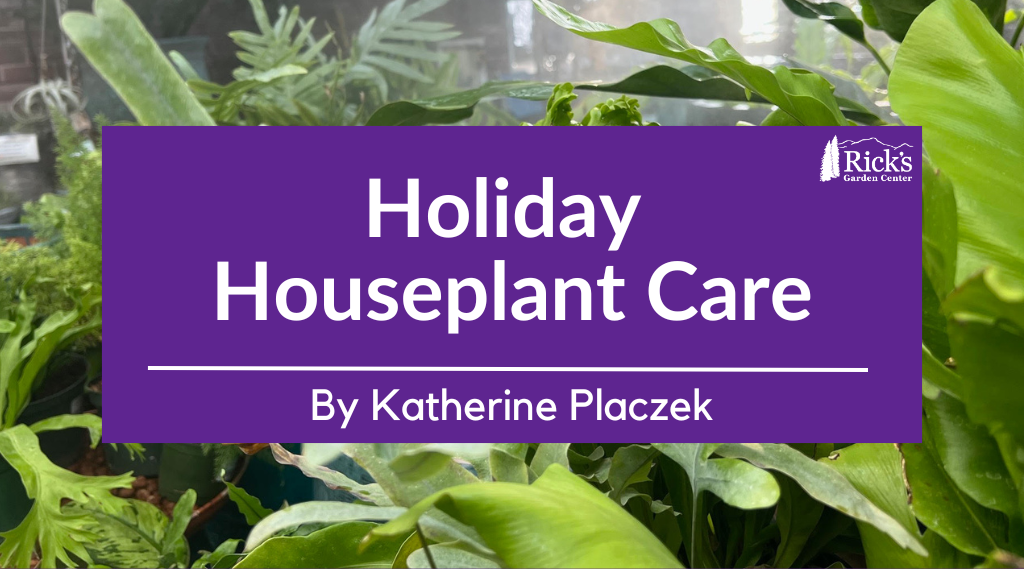
Tool Care Guide
Fall is here! This is a bittersweet moment for me. Harvest has hit its finale, and I am beginning to accumulate a stack of books that will keep me growing while my garden begins to take a snooze. Before I cozy up on the couch, and have a cup of tea- I always take care of my end-of-season garden tool maintenance. Garden tools should have regular TLC, especially after use, but in reality, this may not happen. I will detail daily care at the end of this article for your convenience.
End-of-Season Garden Tool Maintenance:
Deep Clean and Oil Pruners:
This is imperative to reduce disease and rust on your snippers, prolonging their use.
- Pruners should be taken apart and deep cleaned at least once each season.
- Unscrew any nuts/ bolts that hold the pruners together.
- Wash all parts separately in soapy water.
- Soak all parts in vinegar, then rinse with water.
- Rub with steel wool to remove any rust, then rinse and dry.
- Soak in diluted bleach water to sanitize, then rinse and dry.
- Buff with linseed oil and reassemble.
Sharpening:
Both pruners and Hori knives, as well as long-handled tools (hoes and shovels), need to be sharpened every season. Keeping pruners sharp helps produce clean cuts on plants, reducing the entry of any disease. Other tools benefit from a sharpening, making your life much easier. Digging a hole to plant with a dull shovel is no fun!
- Anything you are going to sharpen should be cleaned first. Long-handled tools may not need the vinegar/ bleach/ oil treatment unless there are concerns about rust.
- Push the sharpening file in the same direction across the blade and follow the original blade angle. Do not rub the file or stone back and forth, this does not sharpen but dulls the blade further.
- Smooth these newly filed edges with a sharpening stone.
- We recommend wearing eye protection and gloves when sharpening to protect against metal slivers.
Care for Wood Handles:
With long-handled tools, it is important to take care of wood handles. Utilize durable tape (think athletic tape or other heavy-duty tape) for minor cracks. Anything that is more compromised should be replaced immediately to prevent injury.
- Wipe down the handles with a damp cloth.
- Inspect for cracks or any weak spots between the handle and the tool head. Address with durable tape or replace the wooden handle if damaged.
- If needed, lightly sand the handle to smooth splinters, and rub linseed oil to condition.
Daily Garden Tool Care (when you have time!):
Generalized care:
- Rinse any digging tools, then use a wire brush or something similar to get rid of any stuck dirt or debris.
- Scrub snippers down with a brush and soapy water.
- If any tools were used with diseased plants or infected soil, make sure you disinfect them before any other use. Soak the infected tools in a diluted solution of 2 cups of bleach mixed with 1 gallon of water. Then rinse in plain water, and follow with a generous wipe of rubbing alcohol.
- Before storing tools, rub them dry with a rag.
- To help prevent rust on digging tools, mix a bucket of sand with plant-based oil, like linseed oil (avoid any petroleum oils, as this reduces plant vitality). The sand should be damp with oil, but not wet. Plunge any blades, tines, or teeth into the sand a few times for a quick clean, or do this following regular maintenance once the tools have been wiped dry.
- Store your tools in a dry and well-ventilated place. Small hand tools can be stored directly in a dry bucket of sand or gravel, and larger tools should be hung so as not to dull their blades in a mad scramble.
Removing Sap:
- Wipe blades with a rag dipped in mineral spirits or turpentine.
- Submerge and clean the blades in soapy water. Rinse and then wipe with linseed oil.
Preventing and Removing Rust:
- Soak any tools showing signs of rust in a 50/50 mixture of vinegar and water overnight.
- Scrub the affected areas with steel wool.
- First, wash in soapy water, and then rinse.
- Rub dry and then buff with linseed or a mineral oil.
All tool maintenance requires is a little elbow grease and time. Sometimes we neglect our tools throughout the season, but I can tell you the reward of pulling out a clean, sharp, and shiny tool in the spring never ceases to make me smile. Happy fall, everyone!

New School Fall Gardening Stretegies
By Katherine Placzek
With fall approaching, many of you are getting ready to put your garden beds and other portions of the landscape to bed. With a more eco-friendly mindset, we would like to suggest a couple of tweaks to your typical routine.
Old school: Raking and bagging leaves, tossing them out for the trash.
New school: Rake leaves from below trees, and use them as mulch around your perennials, shrubs, or on top of your vegetable garden beds. You can also run these over with a lawn mower to mulch them into your grass.
Why: Organic matter, including yard waste, is the most prolific item in United States landfills. Consequently, this unsustainable practice directly contributes to greenhouse gas emissions. Conversely, organic material returned to the soil reduces your environmental impact while providing a useful garden resource. These local sources of organic material and nutrition (from your own yard’s leaves) will feed and insulate your yard all winter long! Decomposing leaf matter enriches the soil, adding carbon and nitrogen to the soil, while plants “sleep.” Leaves also create safe places for native bees and other pollinators. Did you know that almost three-fourths of Colorado’s native bees nest and overwinter underground? Tip: Deeply water the leaf litter in after it has been placed. This creates a wet decomposing mat that will not blow away as easily.
If you have excess leaves that you are not going to be using, please feel free to bring your bagged leaves by our nursery gate (located at 600 N. 18th St. Colorado Springs, CO 80904). This is a community pile that other members come to gather for their own gardening usage.
Old School: Trim any perennials and remove them before the first snow.
New School: Leave all of your woody stalks, leaf matter, and ornamental grasses all winter long!
Why: This allows for winter interest and provides shelter for any hibernating insects. This is especially true for native plants that act as habitat for many native and beneficial insects. Larger life forms, including birds and mammals, will also benefit from grass seed heads left standing, and other plants that provide shelter in the harshest months. If this is unsightly for you, trim your plants, but leave the stems and other leaf matter on the ground to help create shelter throughout the winter. When soil temperature has reached 50 degrees Fahrenheit it’s the preferred time to begin trimming these perennials in the spring, after many insects have completed their wintering cycle.
Old School: Let the winter snows water your outdoor plants.
New School: Water trees, shrubs, and perennials on nice days throughout the winter.
Why: Unfortunately Colorado Springs does not get enough reliable winter moisture to overwinter many plants. This is especially true for newer plants that do not have an established root system yet. Many trees and shrubs, even those that are well-established, should continue to be watered on warm winter days from October through March. When it gets up to 40 degrees Fahrenheit, pull out a hose or dust off your watering can and soak up some of those winter rays, yourself, while you water. Make sure you unhook any hoses after use, as temperatures can cause freezing in the hose bib and other hardware.
Old School: Say goodbye to gardening until spring.
New School: Fall and winter sow, including vegetable and perennial flower seeds.
Why: Many annual vegetables and perennial flowers have a natural cycle where they drop seeds or fruit in the fall. Mimic nature and plant some of your own seeds in the fall to see what comes up earlier and hardier in the spring! In the vegetable garden, this especially works for cold hardy greens. Think spinach, lettuce, arugula, radicchio, etc. For perennial flowers, like wildflowers, it is recommended to put these seeds down in the fall, as many of our native flowers require a cold stratification period. While many people may set up sections in their freezer and fridge for cold stratification processes, direct seeding in the fall eliminates the juggling of space in your fridge/ freezer. Let the ice cream stay where it is!
Old School: Wait until spring to amend any of your garden beds.
New School: Amend your garden beds in the fall so you can plant right away in the spring.
Why: Fall is a good time to test your soil so you know how to amend your beds. Our soils typically fall in the basic pH range here in the greater Colorado Springs area. This can impact how readily available nutrients are to our plants. Do your research and get your soil properly in shape for your spring! Remember that you can also amend with what nature provides; leaves, manure, compost, and other organic matter. These sources do not have a precise N-P-K (macronutrients: nitrogen, phosphorus, potassium), nor spelled out micronutrients (calcium, magnesium, iron, etc) so it is recommended to test your soil in the spring again to see how your soil has changed due to any unregulated organic material. We offer pH and N-P-K, testing in-store, but the CSU extension office also offers a wide range of soil tests.
Now that you know these new school techniques, you might just try other new gardening techniques in the growing season. I know, I know- I am getting ahead of myself! Happy gardening!

Coco Coir vs Peat Moss
By Katherine Placzek
Dear reader,
This article began initially with a straightforward trajectory. I was going to lay out why using peat moss in soil mixes is environmentally harmful and that we all should make the switch to using coco coir. But as I continued my research, I found it was not that simple and the subject required lots of continued digging to find accurate information. Instead, I am going to try to educate you on both substrates to the best of my ability.
Peat Moss:
Why is it used:
Peat moss has an incredible water retention capability- holding 20 times its weight in water. It also has a small but not insignificant amount of nutrients. You can pot a plant directly in peat moss and it will grow due to these nutrients. It is light and fluffy, used by many gardeners to lighten existing soils. It is highly acidic if not amended with lime, and shrubs like hydrangeas or blueberries can successfully be planted into peat. It also can be used as a pea/bean inoculant. It was not until the 1970s that peat became commonplace as a planting substrate for plant people.
How is it harvested/manufactured:
Peat bogs have centuries (possibly more) worth of plants and decomposing peat/sphagnum peat growing and compacting in a dynamic cycle and ecosystem. It is estimated that peat bogs contain more than 44% of all the Earth’s soil carbon and thus are considered a carbon sink (where carbon is stored and absorbed from the atmosphere). Harvesting practices vary in different bogs and countries. The majority of the peat sold in the United States is harvested in Canada. 95% of all peat in Canada is harvested in partnership with the Canadian Sphagnum Peat Moss Association (CSPMA). The CSPMA has strict regulations that they follow, and are involved in many ecological restorations, as well as scientific research behind peat bogs, and the living organisms that use the bogs as habitat. Many of their practices publicize that they attempt to reduce harm, prevent overharvesting, protect habitats, and replant as part of their aim toward sustainability. While this sounds good, in 2021, it was reported that peat harvesting released 2.1 megatonnes of carbon dioxide into the environment. That’s the equivalent emissions of the annual emissions of five gas-fired power plants. Critics also point out that rehabilitated peat bogs are unable to become a carbon-accumulating ecosystem (or a carbon sink) until roughly 20 years after harvesting. Harvesting in other countries is not regulated and they are likely not as concerned with any harm associated with their practices. All harvesting is mechanical due to utilizing fossil fuels. The UK has banned all peat sales for personal gardens beginning in 2024.
Factors to consider:
- Peat bogs house diverse and intricate habitats for all sorts of living organisms. Harvesting, regardless of practice, disrupts this environment.
- Peat bogs are considered carbon sinks- absorbing carbon from the atmosphere. Harvesting peat releases carbon into the atmosphere, causing concern that this practice contributes to climate change.
- Fossil fuels are used in the harvesting process and are used in the shipping of this product to garden centers and other plant/ home improvement stores.
Coco Coir:
Why is it used:
Coco Coir also has a high water retention rate, retaining 8-9 times its weight in water. It does not have any innate nutrients or pH implications, so it is a neutral starting point as a substrate. Coco coir is a waste product from all other food-grade products made from the meat/ milk of the coconut. Before the 1980s, millions of tons of coco coir were left to decompose in large piles, often taking close to 20 years to decompose. Now there is a market for this “waste product,” as a soil substrate.
How is it harvested/manufactured:
Many coconut plantations are based in the poorest countries, Sri Lanka, India, Vietnam, the Philippines, and more recently, in Central and South America and even Mexico. Coconut plantations are often monocultures that reduce natural biodiversity and cause displacement of living organisms. Coconut trees produce a lot of coconuts but do so at the cost of soil degradation. The coconut hull first is soaked in water (freshwater or saltwater) for a long time to break down the fibers on the hull. This process is called retting. The retting process generates water pollution. Among the major organic pollutants are pectin, fat, tannin, toxic polyphenols, and several types of bacteria including salmonella. While scientists are experimenting with treatment options, there does not seem to be a broad-scale accepted solution at this time. This wastewater is often returned to the local community’s water supply or the ocean. Then, either the coconut hulls can be highly processed through mechanical mastication, or beaten and broken down further by hand. This manual process creates a lot of dust, and workers are typically not provided any PPE (Personal Protective Equipment). Reports indicate an increase in respiratory illnesses in communities with coco coir processing. Many of the following processes, if mechanized, are achieved with fossil fuels. There are currently no regulations on the industry’s standards. I also found conflicting information on whether a second rinse with chemicals is necessary, so that is an additional set of pollution outputs to consider. In general, it’s harder to find reputable sources explicitly sharing information about coco coir. This makes me concerned about the transparency of the industry, as well as possible offenses that are intentionally hidden from the public’s knowledge.
Factors to consider:
- Many coconut plantations are monocultures, created by destroying native habitats for diverse organisms, thus causing soil degradation.
- Pollution of the environment due to wastewater from retting processes.
- The lack of regulations concerning this product allows for humanitarian abuses to occur, including health hazards for workers and the surrounding community.
- Fossil fuels are used in portions of the manufacturing process and in transporting this product to your local garden center.
I think continuing to use coco coir or peat moss warrants extra research. Dig into the companies that you are supporting. Do they have certifications, and third-party ratings that indicate that they care about their staff’s health and wellbeing? The environment and the community they impact? Their carbon footprint? Other points that you are passionate about?
All of this makes me consider, there have been gardeners and plants people before me who did not have access to these substrates. What did they use before? Compost. Manure. Leaves. Green manures/ cover crops. Aged forest products (humus). Straw. None of these probably have the water retention that peat moss or coco coir boast, but they all have higher nutrition, which means prior plants people did not have to fertilize in the same manner that we do when we utilize a peat or coco coir base. Many of these local inputs are also free. All of this is interesting and will lead to further research on my part.
The most honest conclusion that I can make is that, when we are removed from the product we are buying, we also become naïve of the ultimate cost and any negative impacts of the product. Perhaps, the point here is to grow plants that are acclimated to our growing habitat (for instance, native plants do not need peat or coco coir to thrive), or to build soil from what nature provides in our local vicinity. While this is easy to say, it is harder to do. I think this new knowledge is powerful, though. We can always experiment and try new things in hopes of finding replacements that have a lesser negative impact. Good luck with your own decisions ahead of you!
Soils that we carry that do not contain peat moss or coco coir:
Back to Earth-
- Composted Cotton Burrs (Acidified and Non-acidified)
EKO-
- Clay Buster
- Top Dressing
Happy Frog-
- Soil Conditioner
Rocky Mountain Soils-
- Top Soil
- Humus
- Compost Cow
- Tree and Shrub
Yard Care-
- Soil Pep
Note: We also carry a variety of only coco coir or only peat-based soils, if you decide you prefer one over the other.
Resources to utilize in your own research:
I think that Gardener Scott (A gardener in CO, who has an excellent library of YouTube videos on vegetable gardening) has a comprehensive video on the pros and cons of both of these substrates.
The link to the website that Gardener Scott references: https://www.gardenmyths.com/coir-ecofriendly-substitute-peat-moss/
Canada’s National Observer on the carbon footprint of peat harvesting: https://www.nationalobserver.com/2023/07/07/news/canadas-carbon-storing-peat-digs-climate-dilemma#:~:text=According%20to%20Environment%20Canada%2C%20about,of%20growth%20within%20those%20sites.
21 report on carbon sinks and greenhouse sources in Canada: https://publications.gc.ca/collections/collection_2023/eccc/En81-4-2021-1-eng.pdf
A Q&A with the Canadian Sphagnum Peat Moss Association (CSPMA):
The CSPMA’s website (includes the history of peat, how their manufacturers harvest peat, industry reports, and more) https://peatmoss.com/
Generalized information on how coco coir is made: https://www.madehow.com/Volume-6/Coir.html
Another source on how coir is made: https://coir.com/utility/how-to-make-coconut-coir-the-manufacturing-process/
A study linking coco coir to impaired respiratory function: https://www.thepharmajournal.com/archives/2023/vol12issue3/PartAR/12-3-455-522.pdf
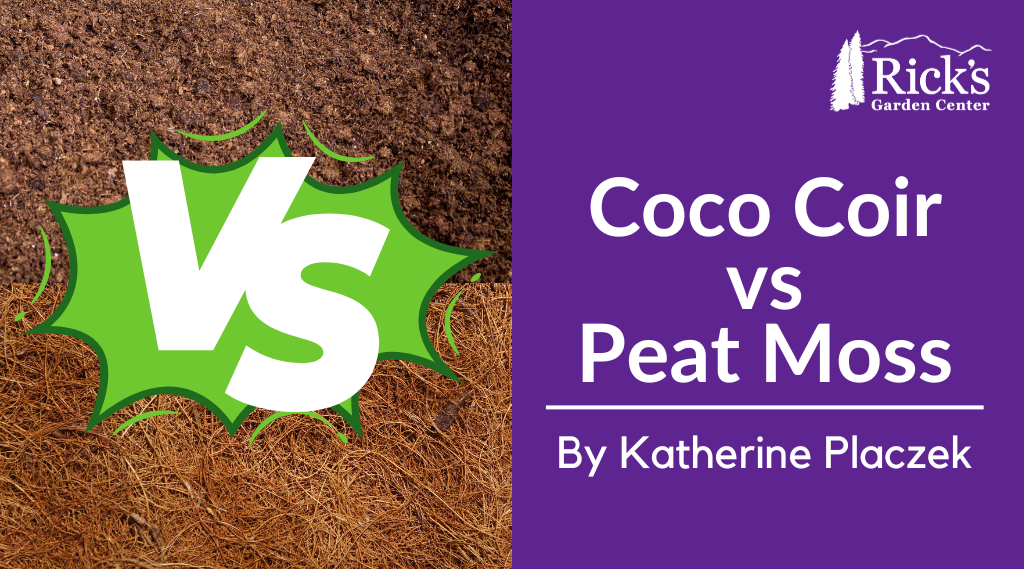
Protecting Our Watershed While Gardening & Landscaping
By Katherine Placzek
Every item that we use in our green spaces– fertilizers, pesticides, sprays, powders and granules, etc. all make their way into the water, after it rains or when we water our plants. This means a myriad of compounds, organic and synthetic, are making their way in our or someone’s drinking water. Yes, most of our drinking water is filtered, but this also impacts lakes, streams, aquifers, wells, and other sources of water that can be a habitat for other living organisms, big and small. While this may feel overwhelming initially, we have the power to make little meaningful changes in the way we manage our landscapes.
Lawn and Garden Fertilization
Three things make a difference here. Quantity, quality and timing:
Quantity: When you use fertilizer, always use the instructed amount of fertilizer or a diluted/ lesser amount. This ensures that your plants can take up the applied fertilizer and that excess is not making its way into our waterways. Excess fertilization can stress plants and negatively impact water quality. Over fertilizer use through agriculture, golf course maintenance, and community landscaping have contributed to dead zones in waterways. A dead zone is where all aquatic life ceases to exist. First, expansive algae blooms occur that crowd out sunlight, which choke oxygen out of the environment, causing inhabitable levels for any life, plant or animal. While some dead zones do occur naturally, the second largest one in the world is in the Gulf of Mexico, where many of North America’s waterways meet. This dead zone is widely attributed to human causes.
Quality: When choosing a fertilizer, it is advisable to read the ingredients, similar to reading food labels. If you cannot recognize an ingredient, know it is likely synthetic. Not all things that are human made are bad, but do your research. You may decide that you do not want some of these ingredients in your garage, home, yard, and local ecosystem. This is why Rick’s is proud to continue to carry our Organic Lawn and Garden fertilizers. Both of these are gentle fertilizers, with low nitrogen levels, and contain ingredients such as chicken manure, bone meal and blood meal.
Timing: Never fertilize before a severe rainstorm where run-off can take the majority of your fertilizer downstream. This is also cost prohibitive. If you plan on putting fertilizer down before predicted moisture, consider prior to a snowfall, where the melting snow can bring the fertilizer into the ground gently. Also read the instructions. Many fertilizers recommend a fertilizing schedule. Follow this, or see if you can stretch the schedule out further, to reduce the amount of fertilizer that you have to buy and apply throughout the year. Never fertilize more than what is recommended, this can stress the plant, and excess product will be absorbed into the waterways.
Pesticide Use
Pesticides include insecticides, herbicides, and fungicides. Similar to fertilizing, follow the same wisdom regarding quantity, quality and timing. We have said it before, but just to remind you: “While pesticides are convenient and sometimes necessary especially when mitigating invasive plant species, pesticides negatively impact pollinator numbers…. It is important to remember that while applying control products at night can reduce pesticide exposure to several pollinators/ beneficial species, this does not protect nocturnal pollinators such as moths and bats. When we use pesticides there is no current method that does not negatively affect pollinators or their second tier predators, who are further up the food chain (Excerpt from our March 2024 newsletter).” All of these pesticides reach water sources that are drinking water for pollinators and larger organisms: birds, fish, fox, deer, etc. Many of the chemicals used in popular pesticides, including glyphosate do not break down with water. This means the problem is washed downstream, but never away, and can exist in our waterways indefinitely. Manual removal of weeds is no fun- we all know this. When we choose conventional pesticides, we give up clean water. Limiting the amount of pesticides we use in our yards is one step to keeping our watershed less polluted.
General Maintenance
When you mow your lawn, consider mulching the cut grass instead of bagging it unless you use the cut grass in your compost. Mulched grass that has been chopped by the mower multiple times and is spread evenly over the lawn acts as a wonderful additive of organic material to the soil. This method improves water retention, and overall soil health, decreasing your need for fertilizer. If you mulch the cut grass, but leave large clumps of thatch, this can burn your grass and be swept away into a waterway. This process can act similarly to over fertilization, causing algae blooms downstream. Use the same logic with fall leaves. Mulch leaf litter and either use it on your lawn or in your garden, to add nutrition to the soil. Avoid abandoning leaves in gutters, and storm drains, as it increases excess nitrogen in the watershed. In the winter, make sure you are using a low saline and non-toxic ice melt as well. Water guardianship takes place in all four seasons!
Plant Selection
Finally, the fun stuff! Select plants and grasses for your landscape that are resilient to the Rocky Mountain circumstances. When we do this, we automatically reduce the need for mowing, fertilizing and the use of pesticides. Native plants especially, have been living here in the Colorado landscape much longer than any human lifespan. They have been taking care of themselves without any of our human care measures, such as fertilization, and will continue to do so into the future. I believe that by choosing to plant native plants in a landscape, you are actually simplifying your overall workload in the yard. You will fertilize less, you will use pesticides less, and regarding grass, you will mow less. That means more money in your pocket and more sitting on the back porch, sipping on a cold beverage. Cheers!

Blossoms on Your Plate
Are you ready to elevate your gardening game to a whole new level of deliciousness? Well, we’re about to dive into the vibrant world of edible flowers that will not only make your garden pop but also your plate! Many of them are easy to grow, forgiving of rookie mistakes, and will reward you with an explosion of colors and flavors.
Nasturtiums (Tropaeolum majus): These deep burgundy to buttery yellow blooms have a peppery kick, perfect as a spicy twist to salads, tacos, and avocado toasts. Bonus: They’re easy to grow, thriving in poor soil and other neglect. These flowers are high in vitamin C. The entire plant is edible- so try out the lily pad-like leaves also! Deer resistant.
Calendula (Calendula officinalis): Often called “poor man’s saffron,” the golden petals of calendula add a subtle saffron flavor to rice dishes and soups. They’re sun lovers and can tough it out in the Rocky Mountain soil. This flower is also known for its skin-healing properties, consider making a toner with calendula flowers. Deer are typically not a fan of these flowers.
Pansies (Viola tricolor): These adorable flowers come in an array of colors and have a slightly sweet, grassy taste. Scatter them over desserts after dipping them in water and then sugar for a delicate but sweet touch. Or freeze them in ice cubes for fancy drinks. Pansies are cold-hardy and can withstand our unpredictable mountain weather. We had a pot of pansies survive the entire winter, even when temperatures dipped below 20 degrees!
Lavender (Lavandula angustifolia): Known for its calming aroma, lavender adds a delicate floral flavor to desserts, teas, and even cocktails. It thrives in well-drained soil, making it a great match for rocky gardens. We have several varieties that will survive year-round in our nursery area. Look for varieties such as Munstead, Hidot Blue, and Phenomenal. Due to the fragrance of these flowers, deer typically leave them alone.
Rose (Rosa spp.): Beyond being a symbol of romance, roses can be used in various culinary creations. Make tea with their dried petals, infuse honey with their fragrance, or toss the petals into desserts. The rose hips that are produced in the fall are also edible and high in vitamin C. You can make tea from the rosehips as well. We have several varieties of roses, some more bred for their blooms, others are cultivated to be hardy for our mountainous climate.
Borage (Borago officinalis): With its brilliant blue flowers, borage adds a refreshing cucumber taste to salads, drinks, and desserts. The best part? Borage is a self-seeding annual, making it a low-maintenance addition to your garden. The pollinators will also feast on these blooms! Deer typically avoid this plant.
Chamomile (Matricaria chamomilla): Beyond being a bedtime tea, chamomile flowers can be used in salads or infused into syrups that go well in cocktails, over ice cream, or on pancakes. These sun-loving plants will thrive in our bright sun. Deer tend to avoid this plant due to its fragrance.
Dianthus (Dianthus spp.): Also known as pinks, or sometimes recognized as carnations, these flowers have a mild clove-like flavor. Add them to fruit salads, and desserts, or dry them and add them to various spice blends (za’atar, is a great example). Dianthus are hardy perennials, returning year after year. They are also deer-resistant.
Hibiscus (Hibiscus rosa-sinensis): Hibiscus flowers make a delightful and tropical addition to beverages, jams, and desserts. We carry gorgeous hardy hibiscus that will winter as a perennial shrub. Hibiscus also has high levels of vitamin C and is an excellent herb for overall health.
Daylilies (Hemerocallis spp.): Despite their fleeting beauty, daylilies are edible and offer a slightly sweet flavor. Stuff the blossoms with a soft cheese, or add them to stir-fries. Do your research on whether you have a daylily, before digging into a meal. Not all species of lilies are edible. These hardy perennials are a reliable choice in our climate.
Elderflower (Sambucus nigra): Fragrant elderflowers can be used to make refreshing beverages like elderflower cordial or add a subtle floral note to desserts. Elderflowers come from elderberry bushes, so you will also be able to eat elderberries if the birds don’t beat you to it! These shrubs are well-suited for the mountain environment, making them a great choice for your garden.
So, whether you’re a seasoned horticulturist or a budding green thumb, dive into the world of edible flowers and turn your garden into a culinary masterpiece. After all, why just stop and smell the roses when you can toss them in a dish too? Happy gardening and bon appétit!

Embracing Nature’s Way: Integrated Pest Management
Integrated Pest Management is like the Gandalf of gardening – a wise, all-encompassing strategy that balances the forces of nature to keep your greenery flourishing. At its core, IPM is a holistic approach that combines biological, cultural, and physical/ mechanical control methods to manage pests and diseases. Instead of reaching for a pesticide or other control products, we tap into the power of Mother Nature herself to maintain a thriving and balanced ecosystem.
Some of our IPM practices include:
- Biological: Releasing ladybugs or other beneficial insects inside our greenhouses, or hoop houses to feast on those insects that are a bother; aphids, scale, mealy bugs, leafhoppers, etc. We also let spiders do their good work eating larger insects, like grasshoppers.
- Cultural: Reducing watering if fungal or pest problems crop up.
- Mechanical: Manually removing bugs from plants by hand or with water (aphids, mealy bugs, scale, potato bugs, etc)
While we lean into biological, cultural, or mechanical solutions, the last part of IPM is responsibly utilizing chemical products to rid of pests. This means we use more natural controls, such as Neem oil or Spinosad Soap, before other products. It is also important for us to factor in when pollinators or other beneficial insects may be around. So we try to spray when these individuals are not active. We also follow recommended application methods to avoid pollution of our environment or incur undue costs.
Why does Rick’s Garden Center Choose IPM Over Pesticides?
Environmental Harmony:
- Pesticides can disrupt your garden’s delicate ecosystem – effective, but with unintended consequences. IPM, on the other hand, dances with nature rather than against it. By embracing natural predators, beneficial insects, and environmentally friendly practices, we create a harmonious balance that keeps the pests at bay without harming the environment. By mostly avoiding synthetic chemicals, we reduce the environmental impact and create a garden that’s both beautiful and a haven for beneficial insects and wildlife.
Economic Sense:
- Let’s face it – pesticides can burn a hole in our pockets. IPM, however, is cost-effective in the long run. By relying on natural solutions, we reduce the need for constant reapplication of expensive chemicals, improving our bottom line.
Happy and Healthy Plants:
- Picture this: a garden where plants are not only surviving but thriving. That’s the magic of IPM. By addressing the root causes of pest problems and fostering a healthy soil environment, we ensure that your green companions are resilient and ready to face whatever life throws their way.
Community Connection:
- We believe in building a community that shares our love for the earth. By choosing IPM, we invite our customers to join us in creating a garden that is a testament to the power of working hand in hand with nature.
At Rick’s Garden Center, IPM isn’t just a gardening strategy – it’s a philosophy. It is about embracing the rhythms of nature and inviting others to join us toward a more sustainable future. So, next time you visit, know that you are not just buying plants; you are becoming a part of our eco-minded family.

2024 Pepper Book

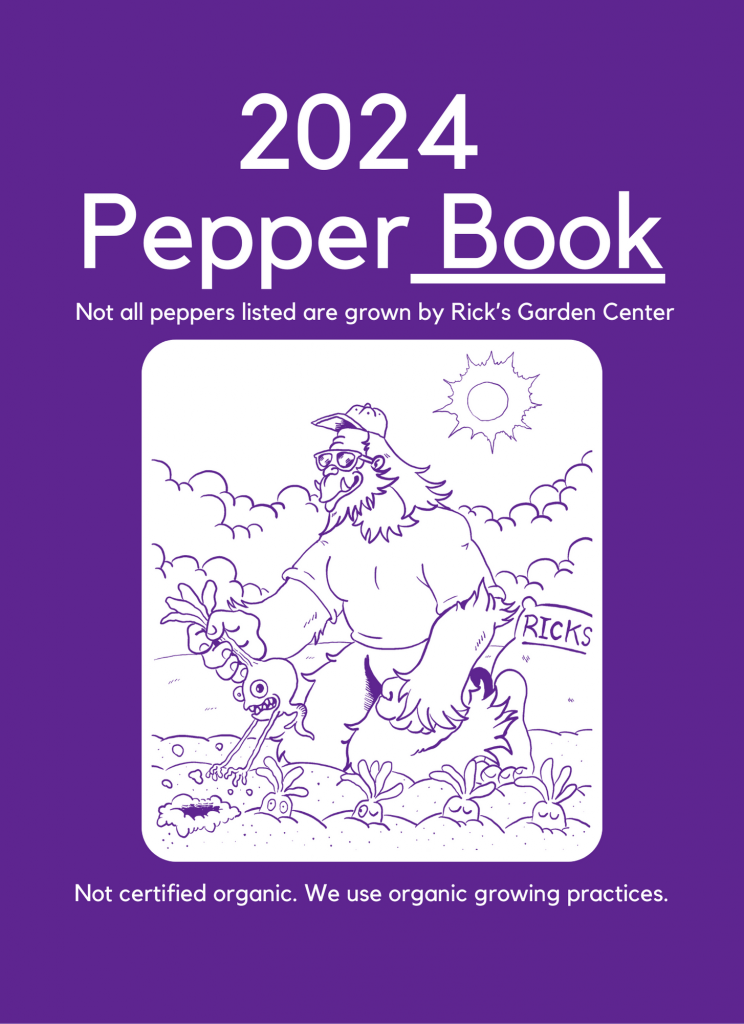

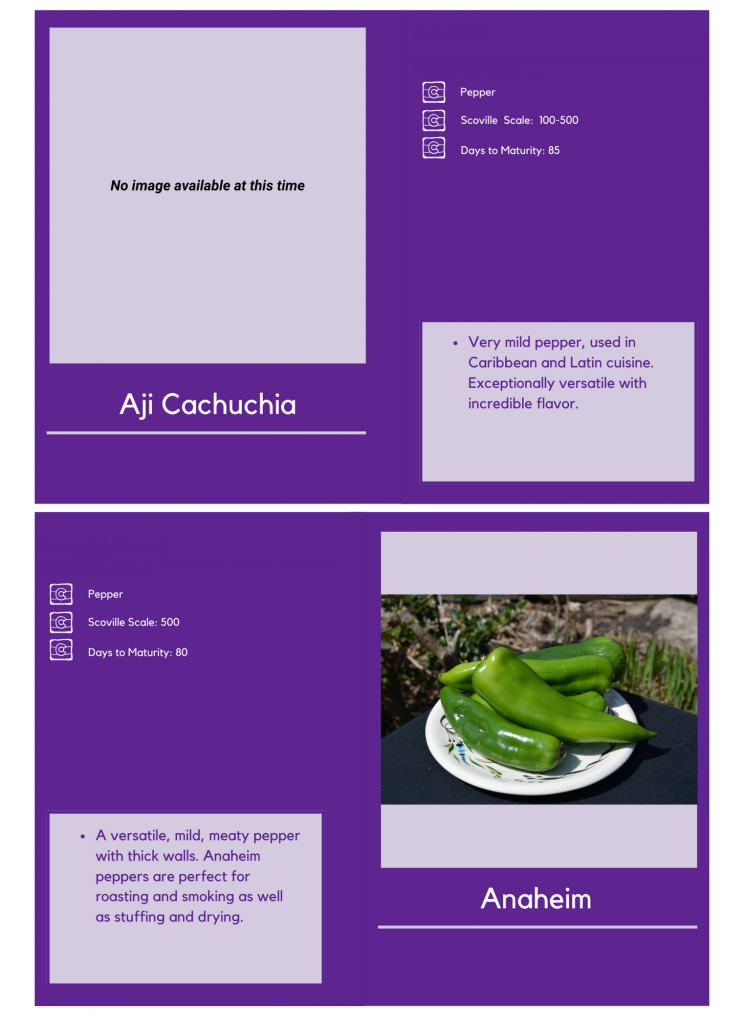

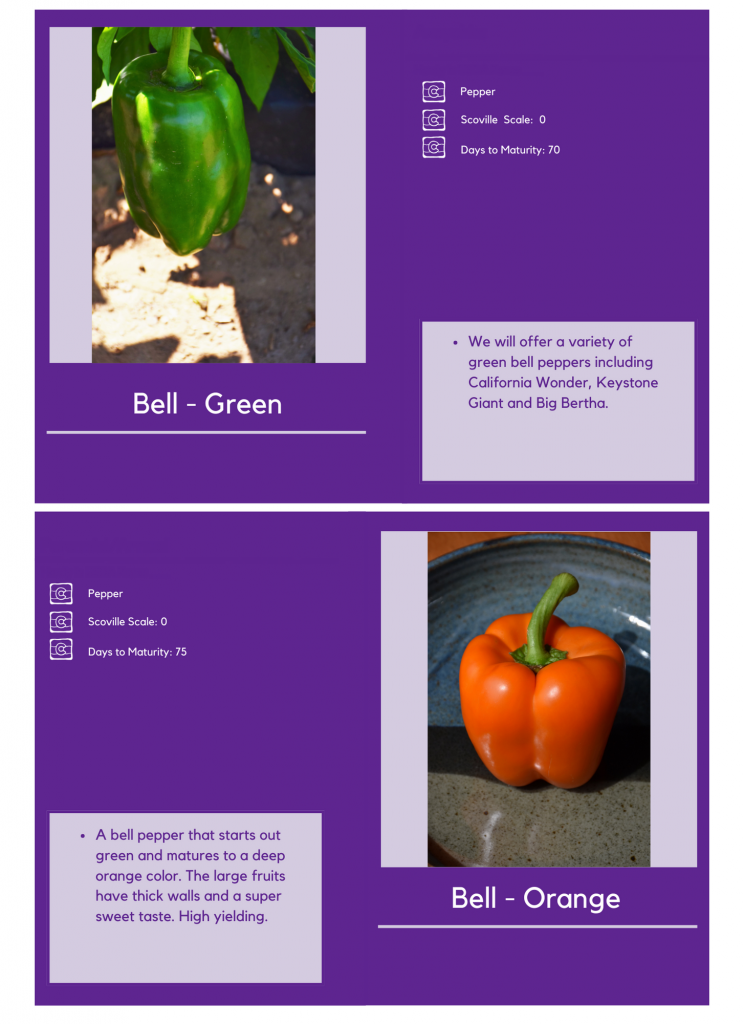









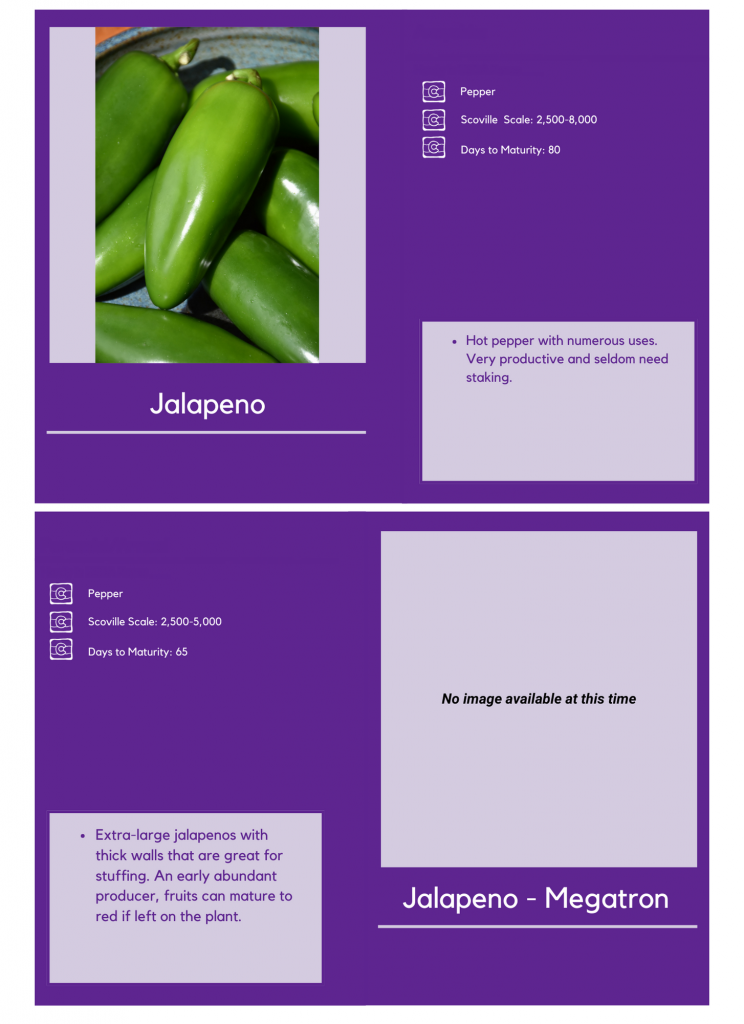



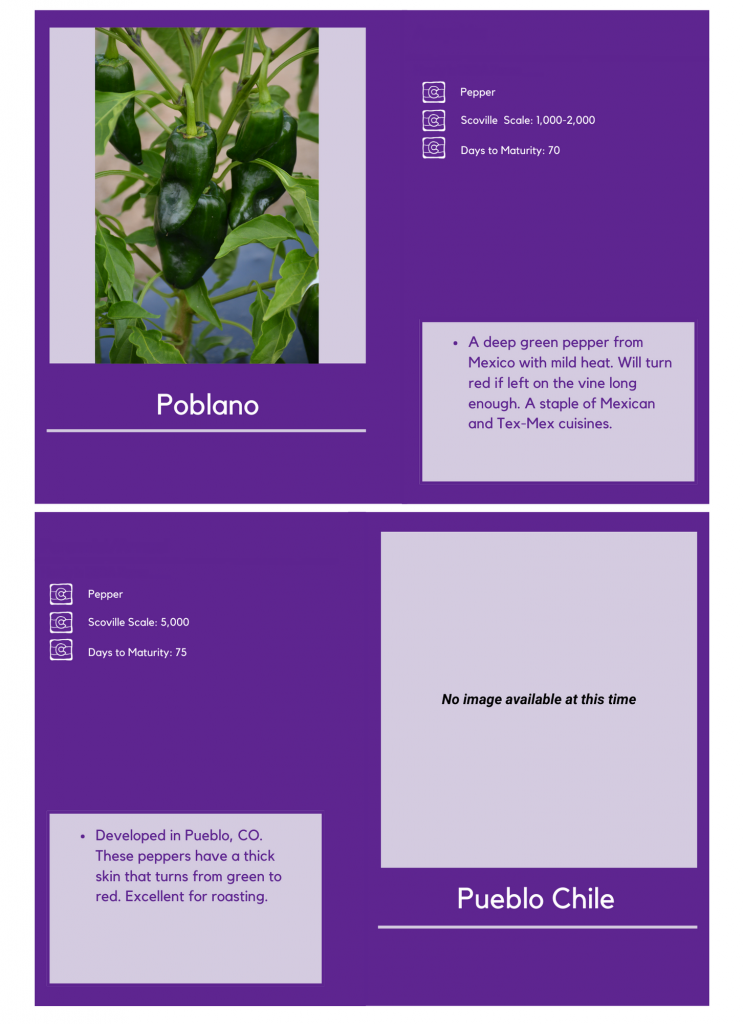



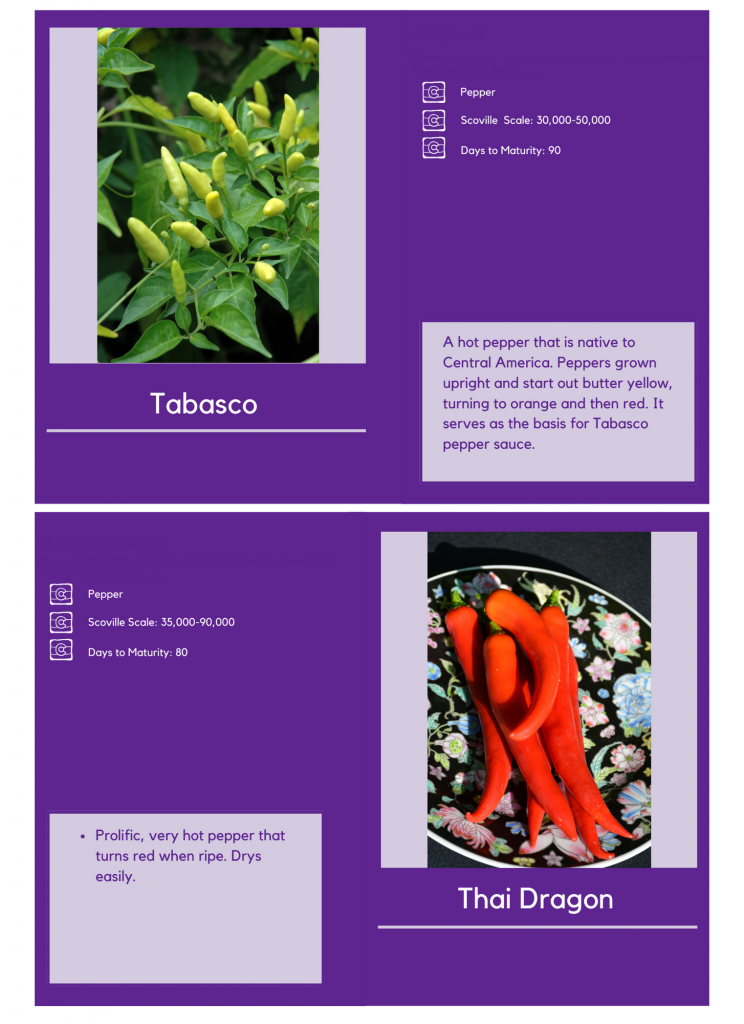

2024 Tomato Book

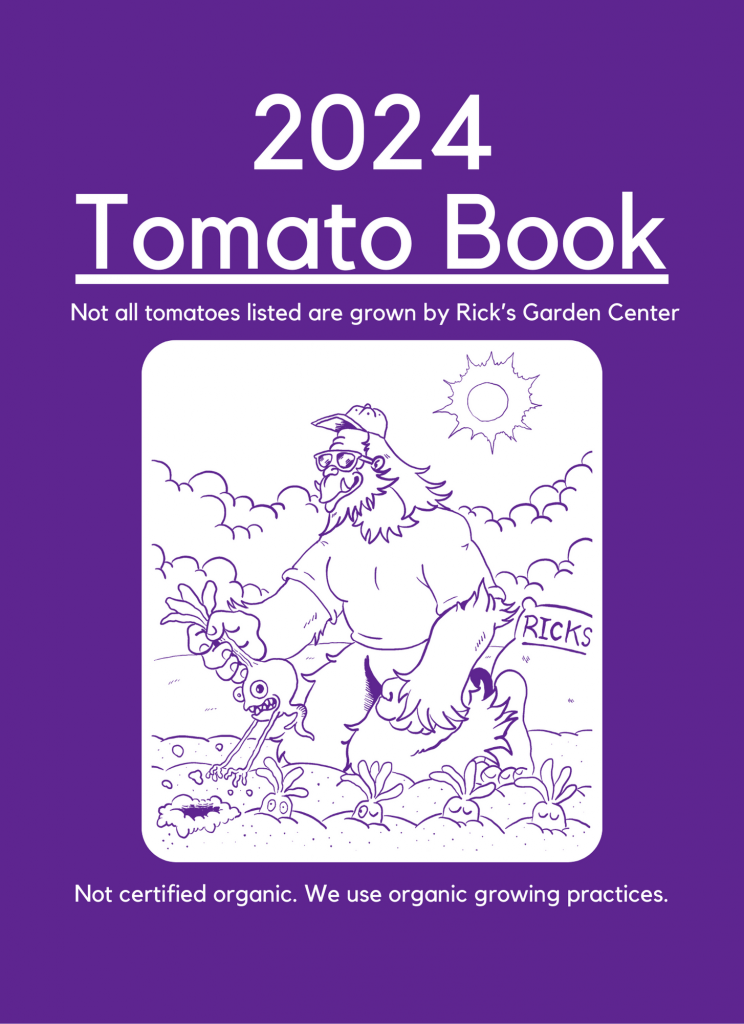
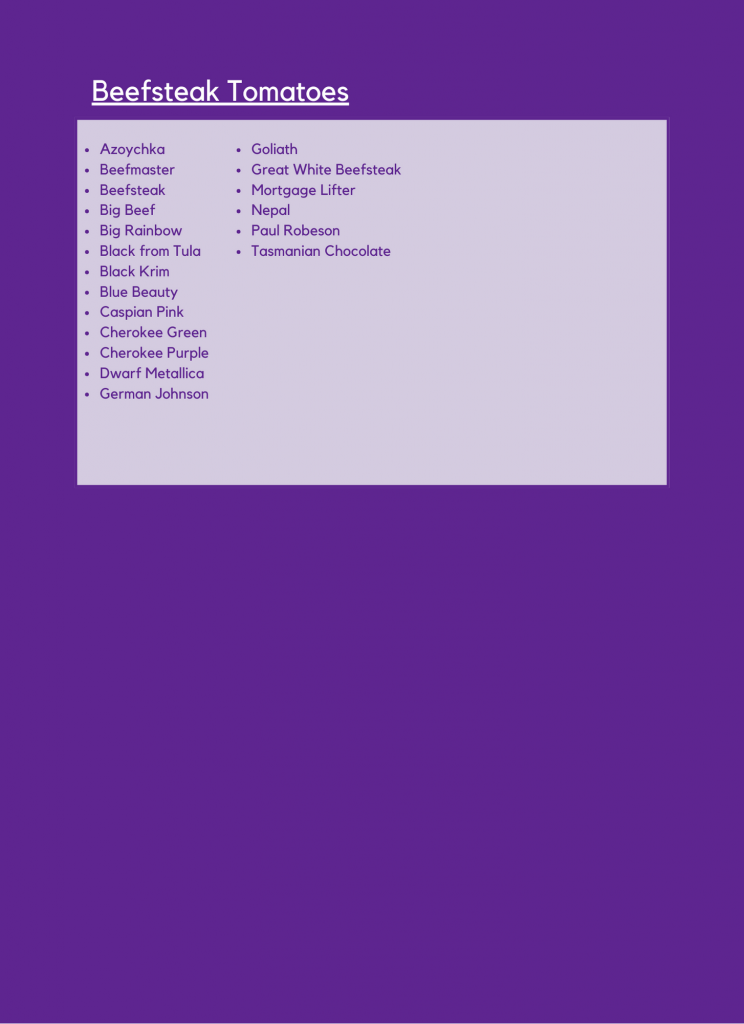



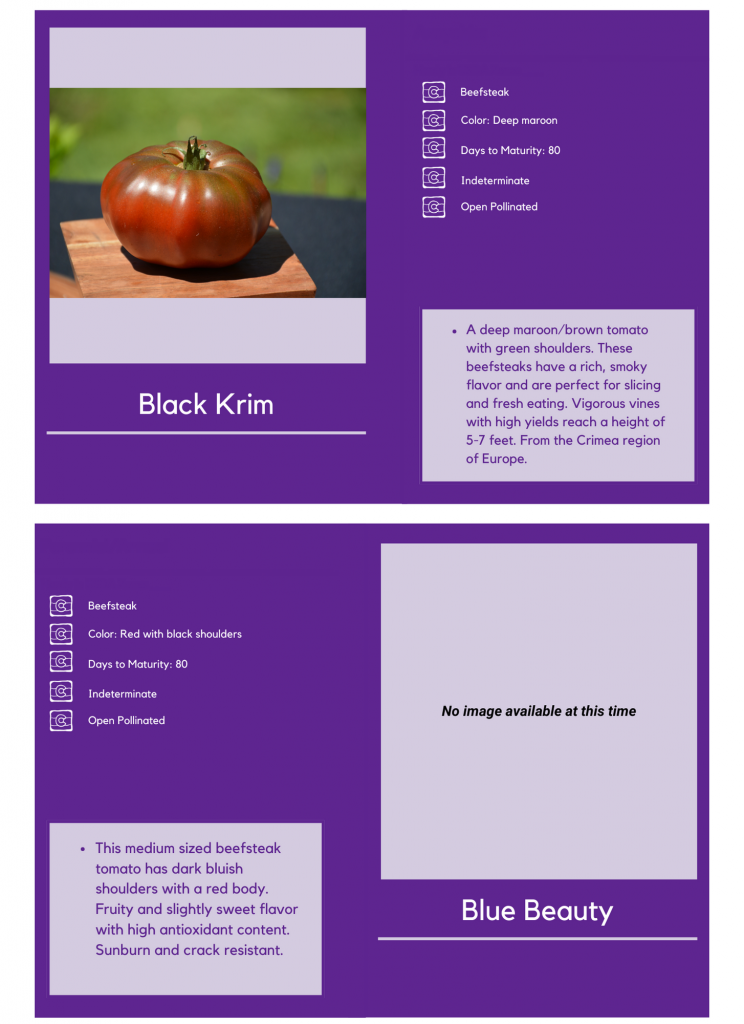

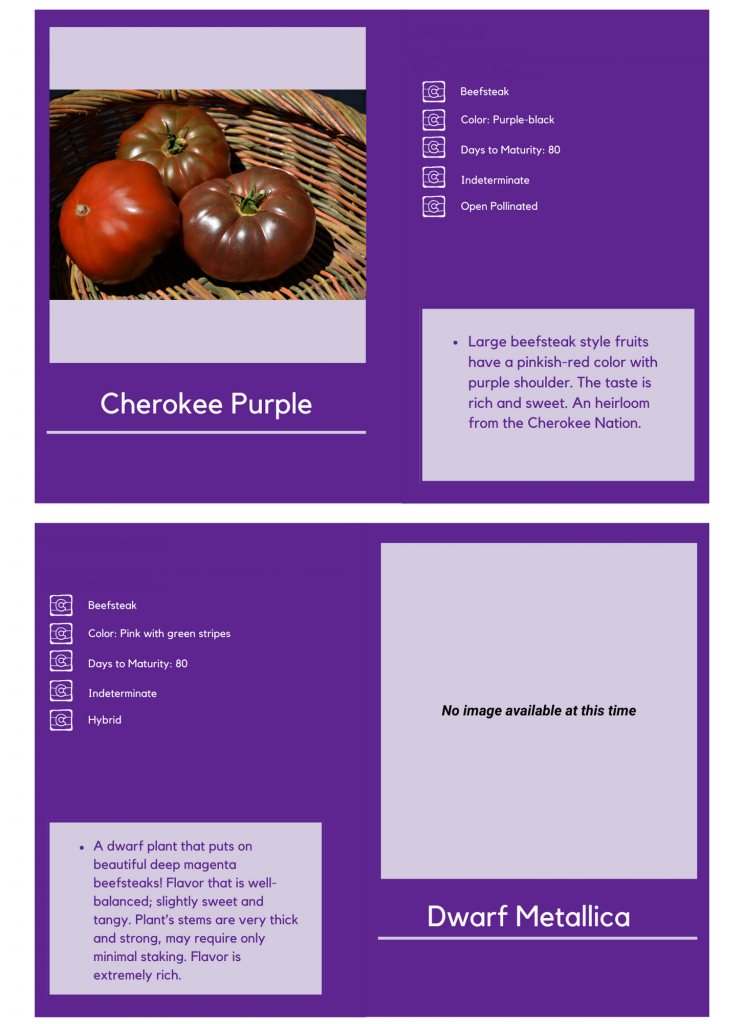

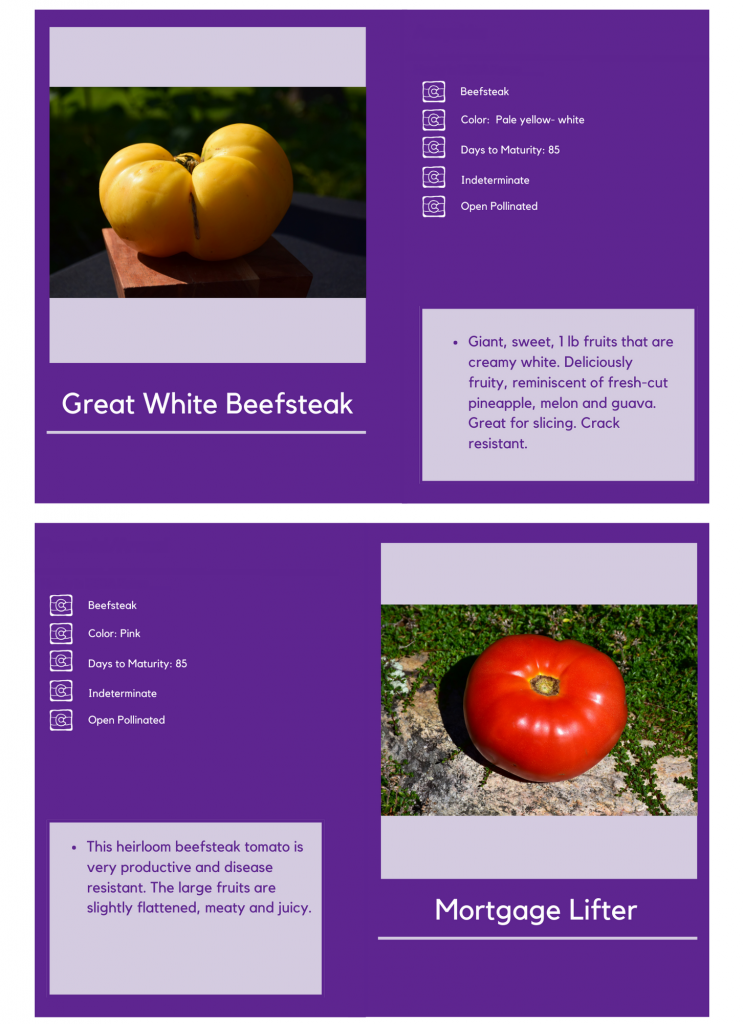
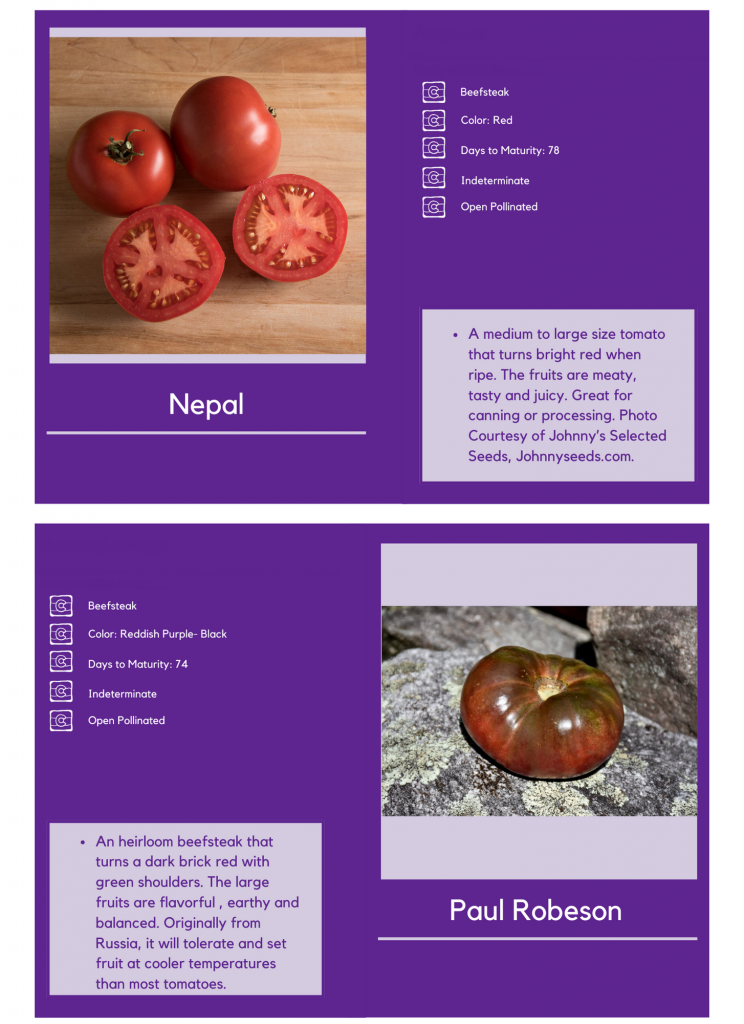
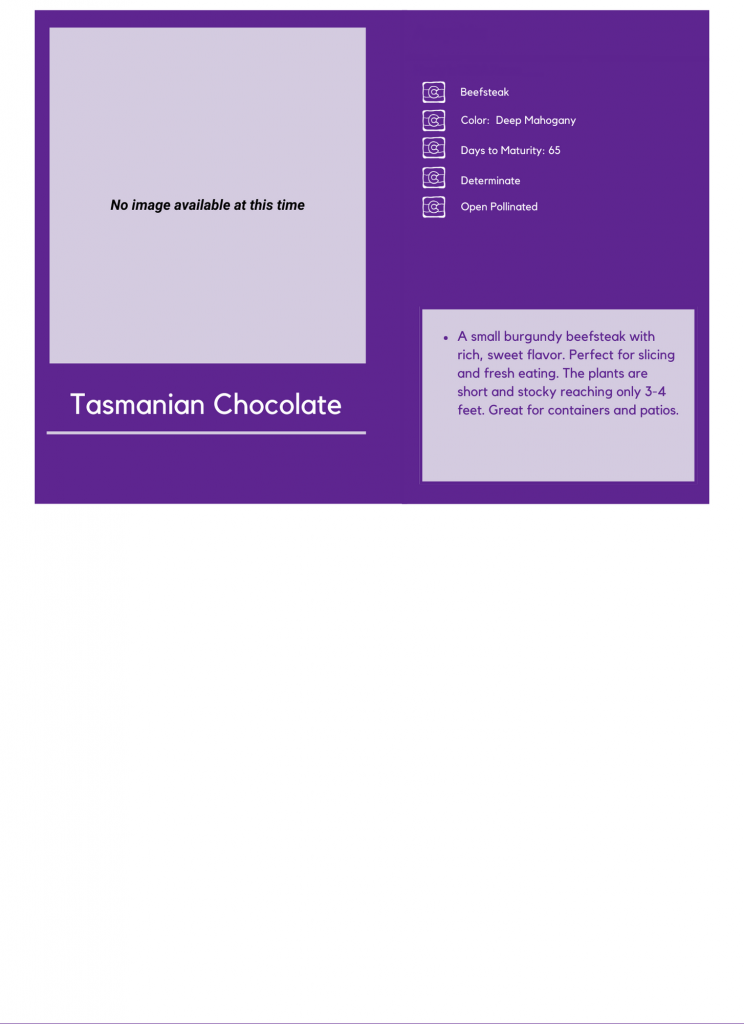
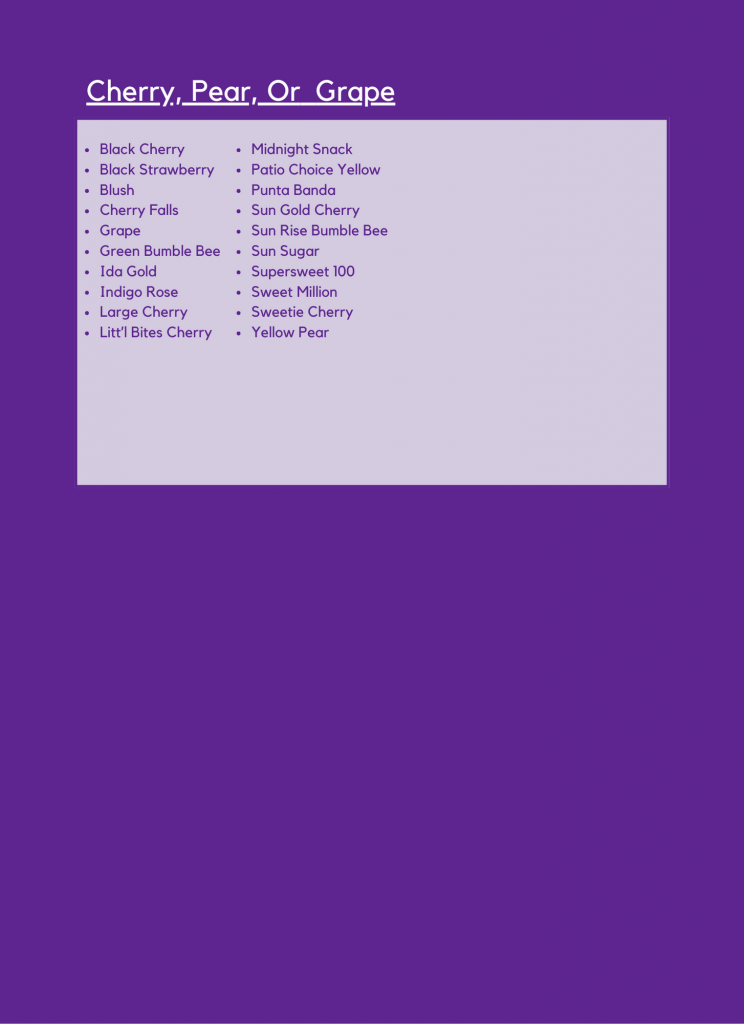
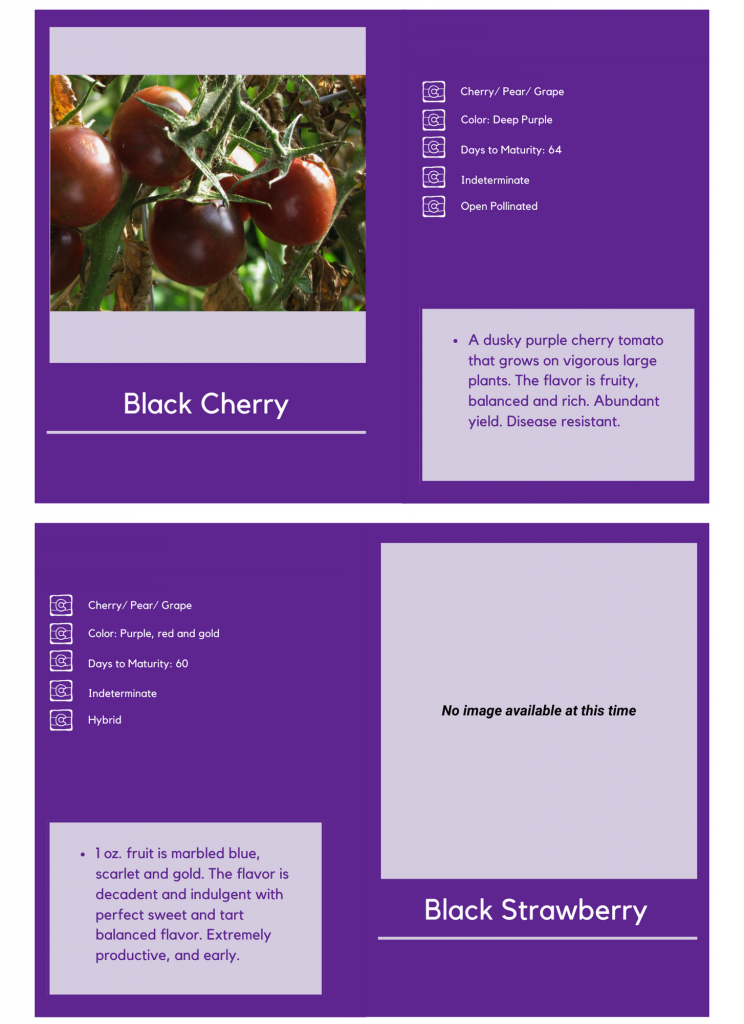




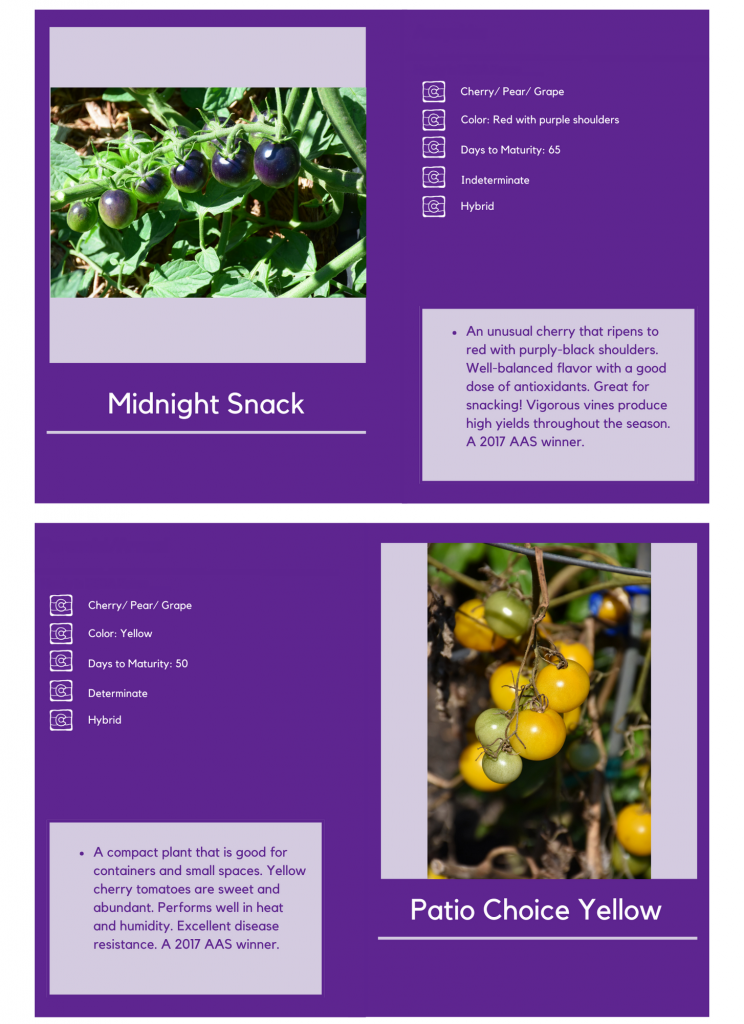


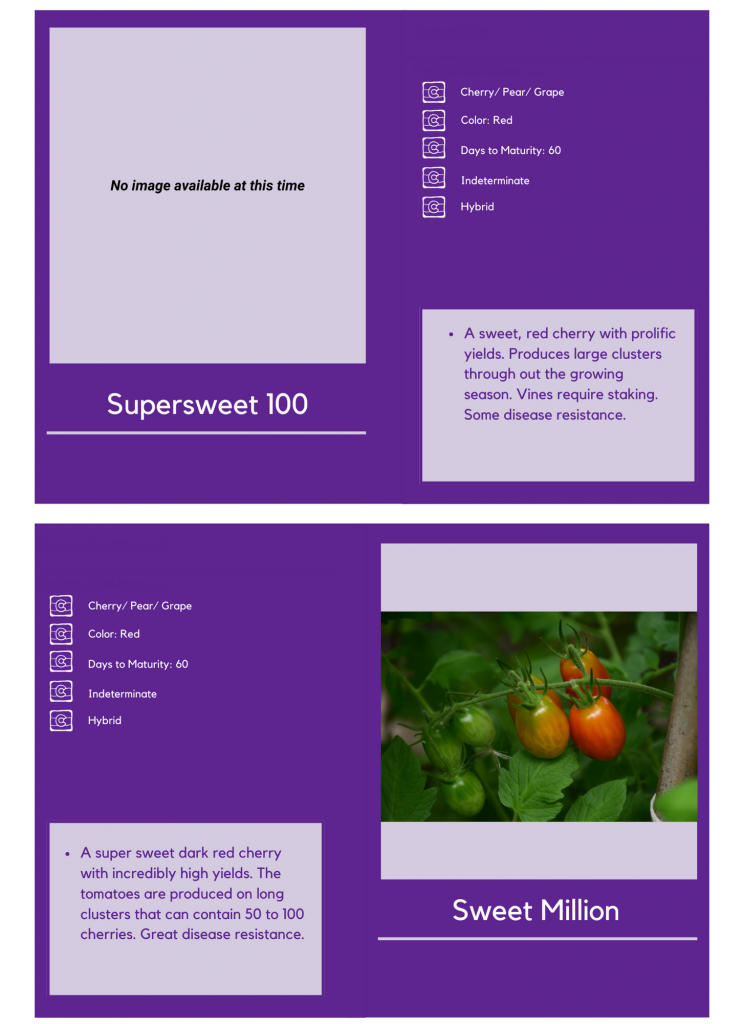

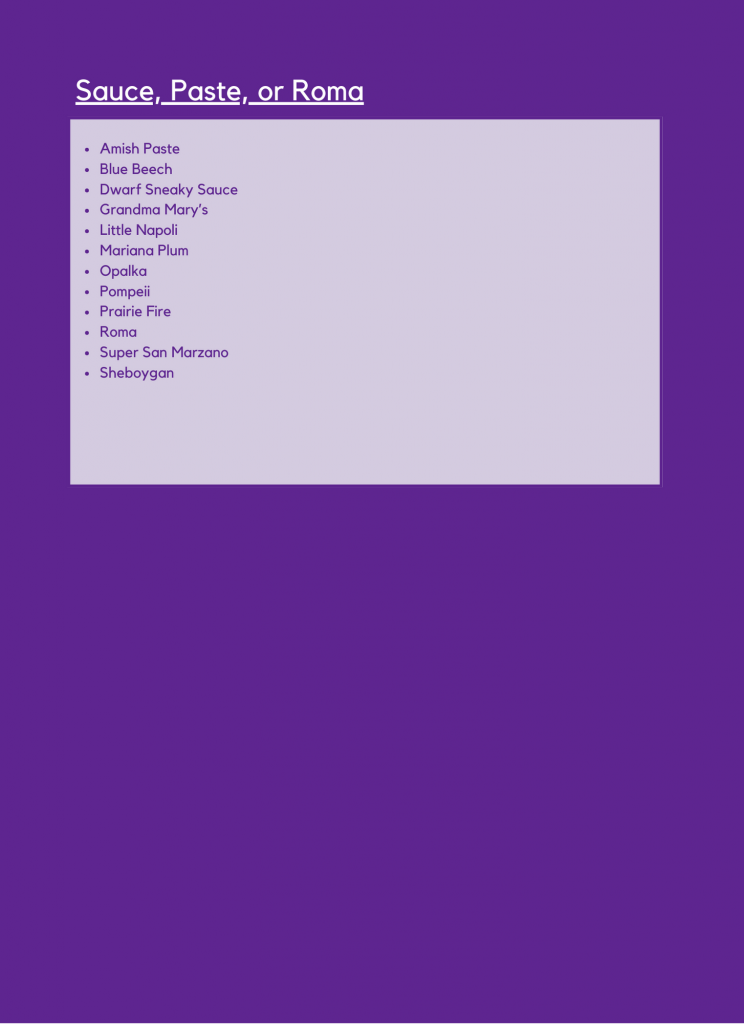


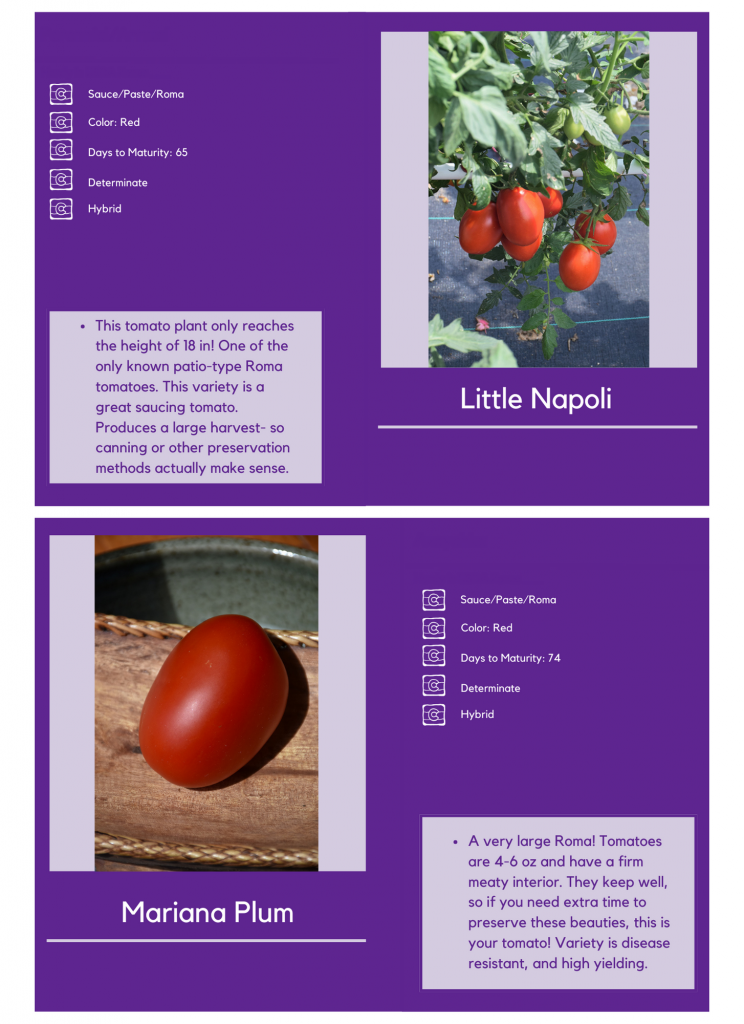
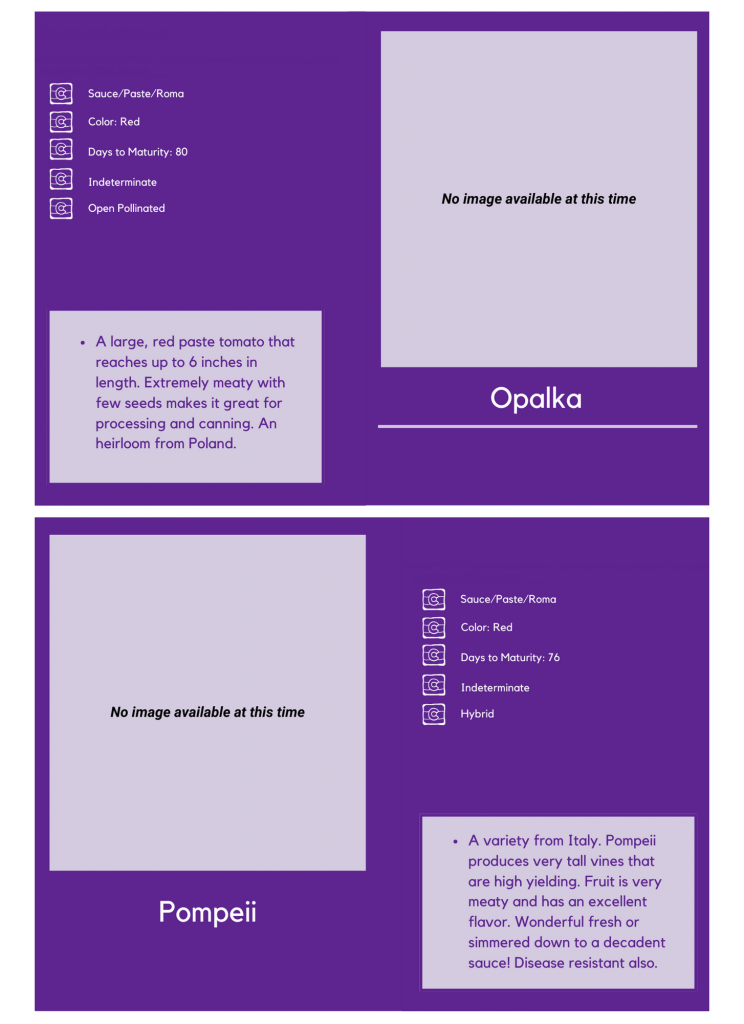






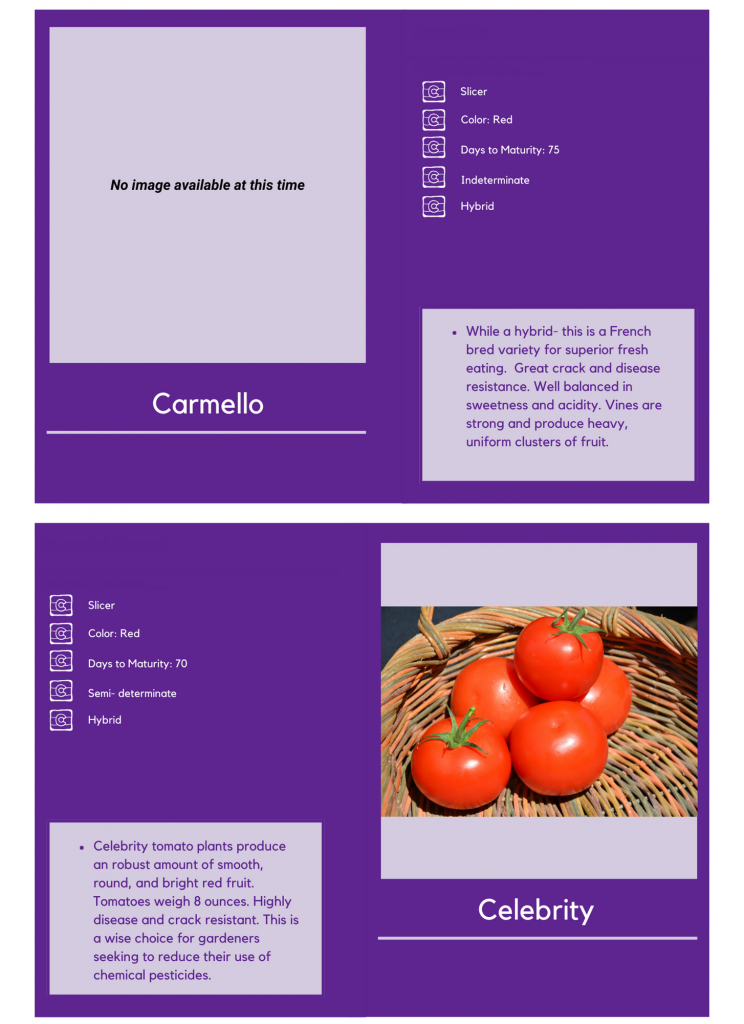
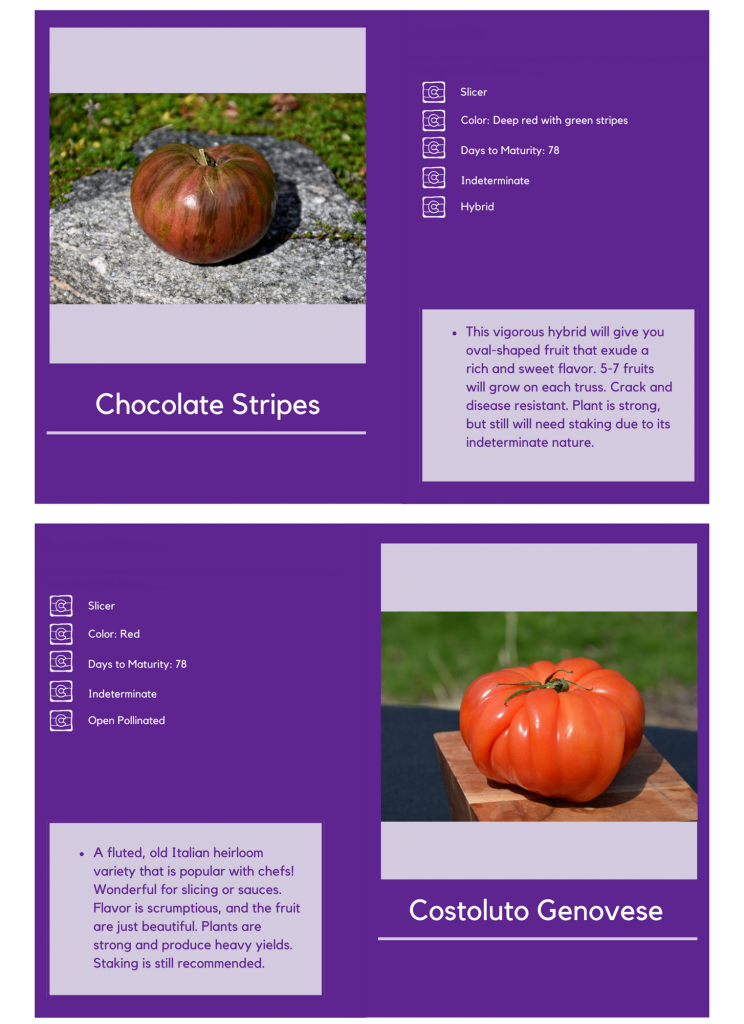
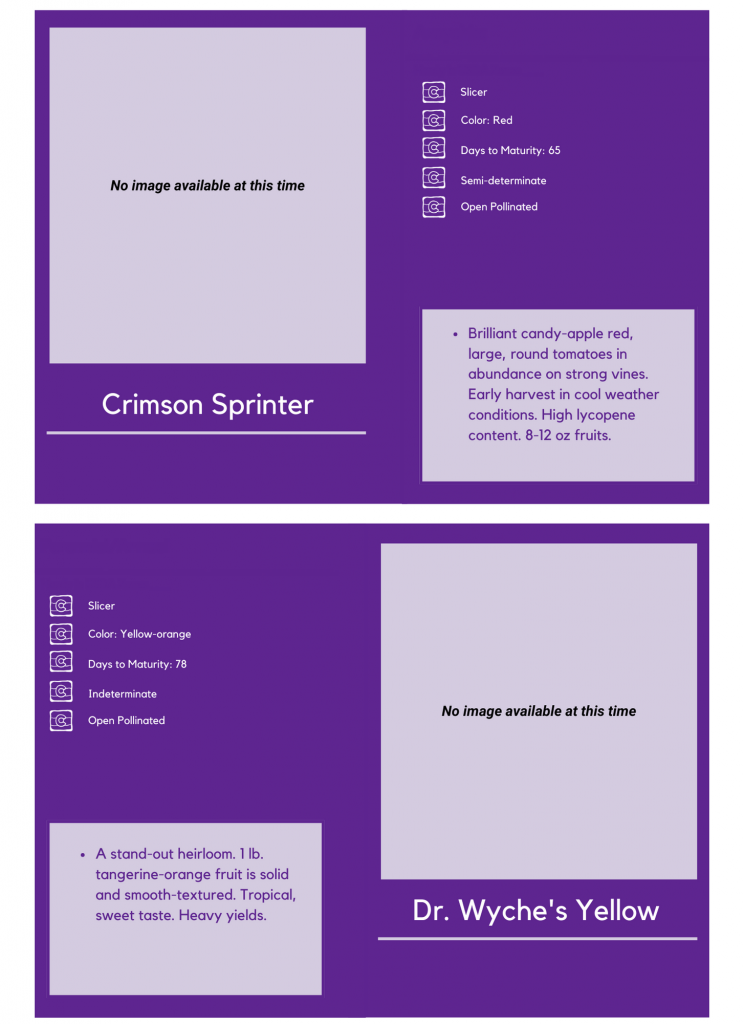




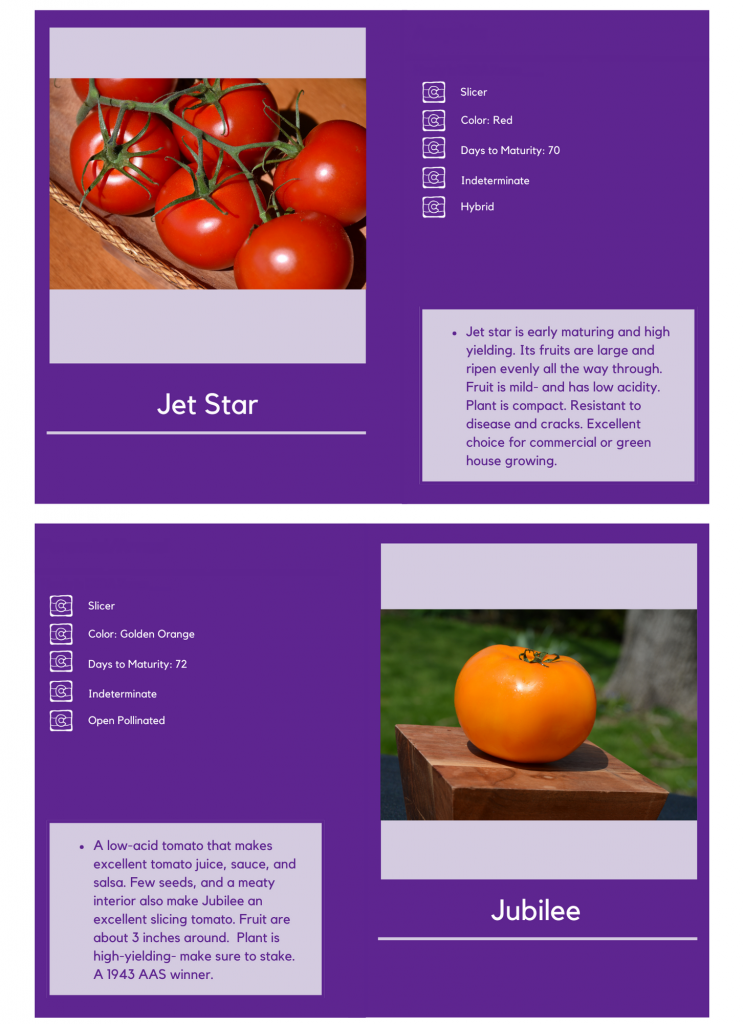
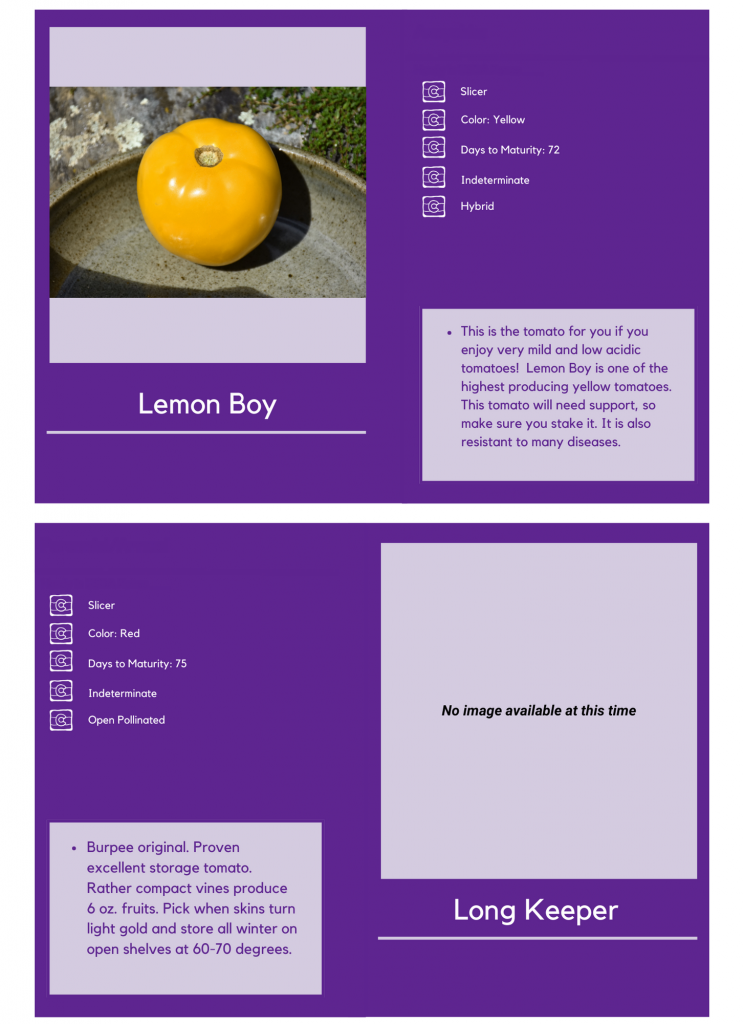


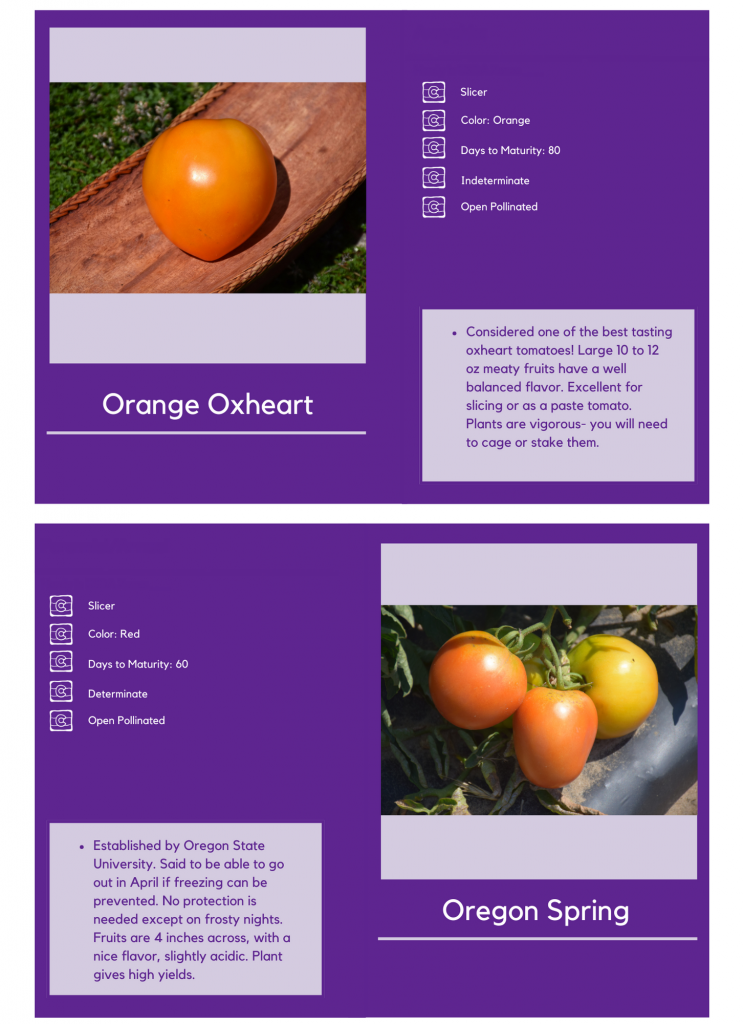
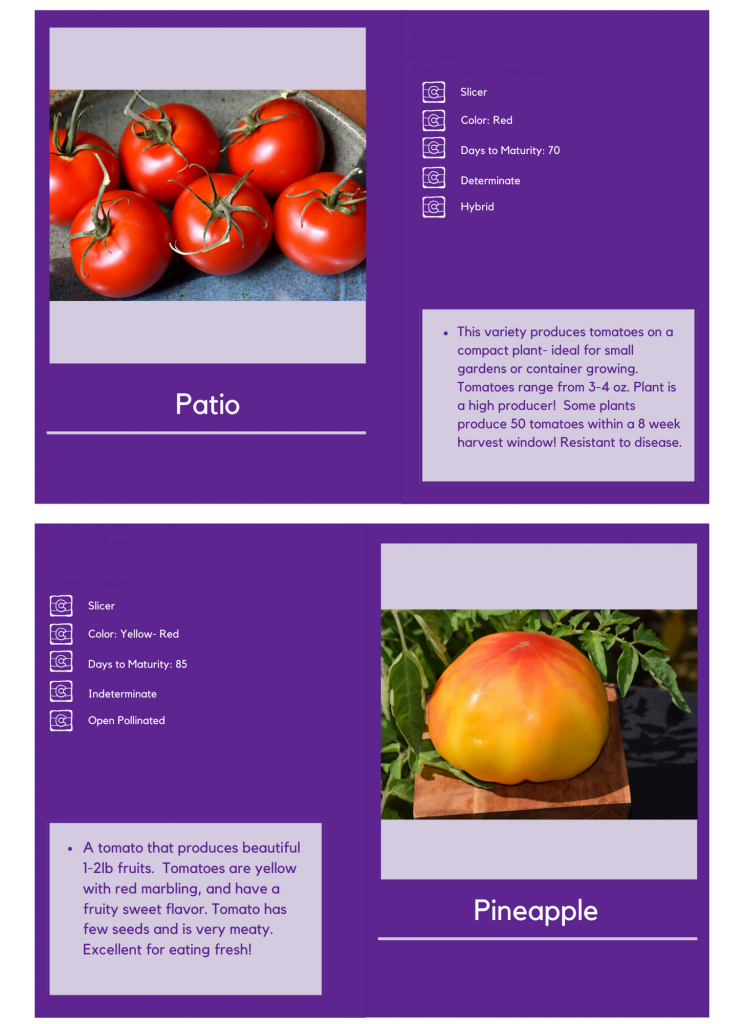

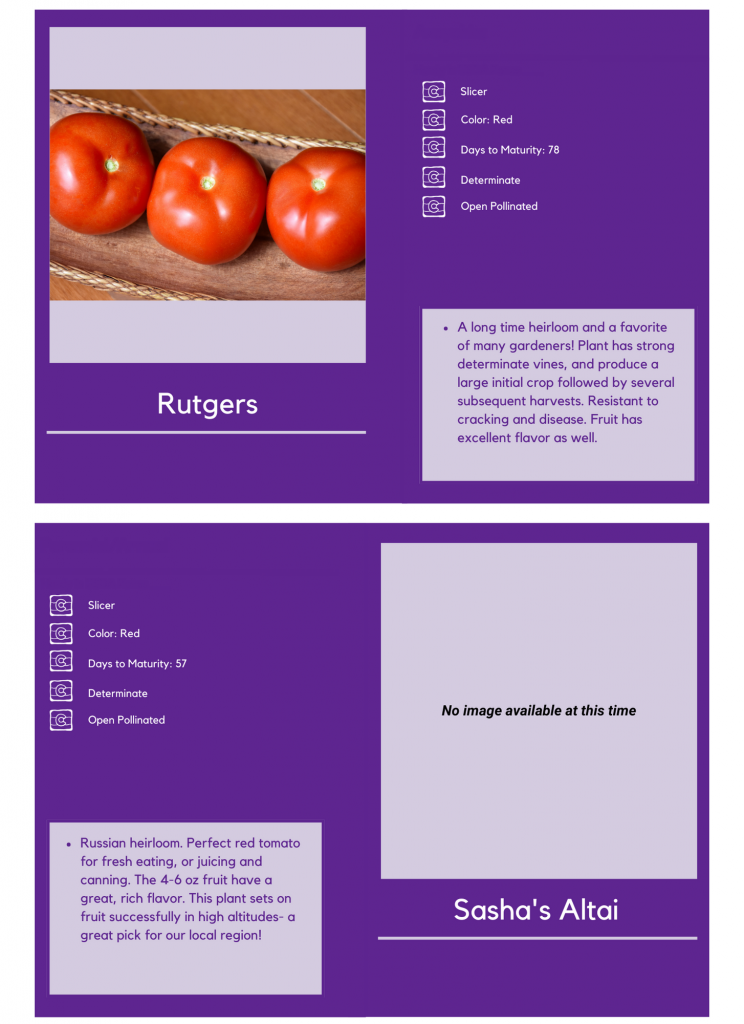






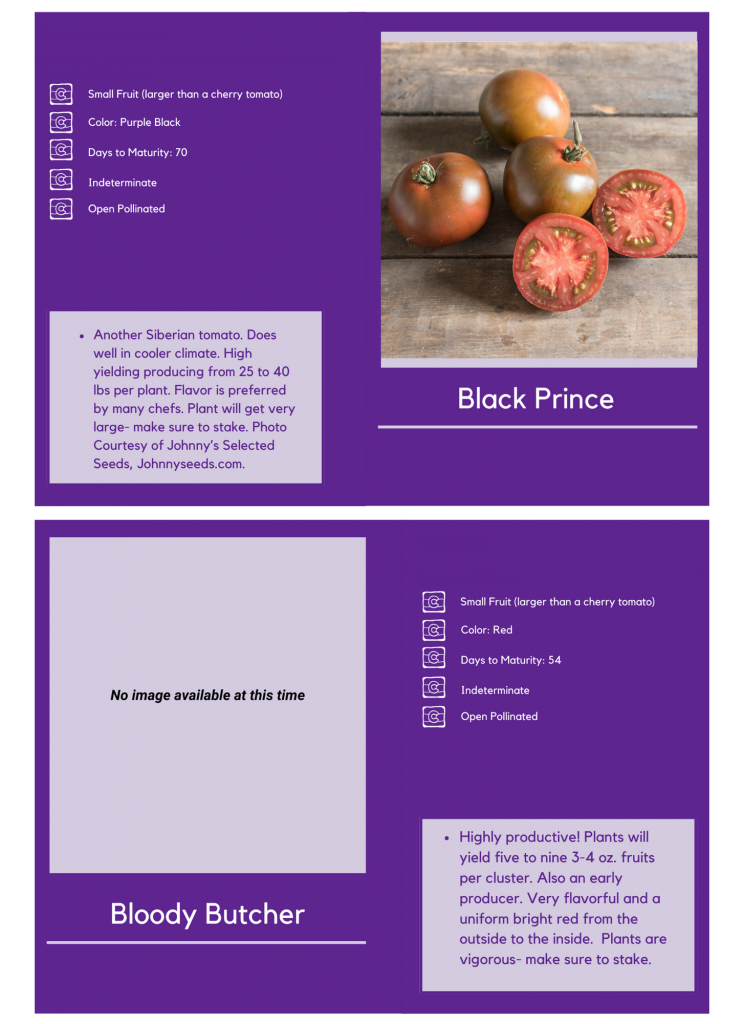




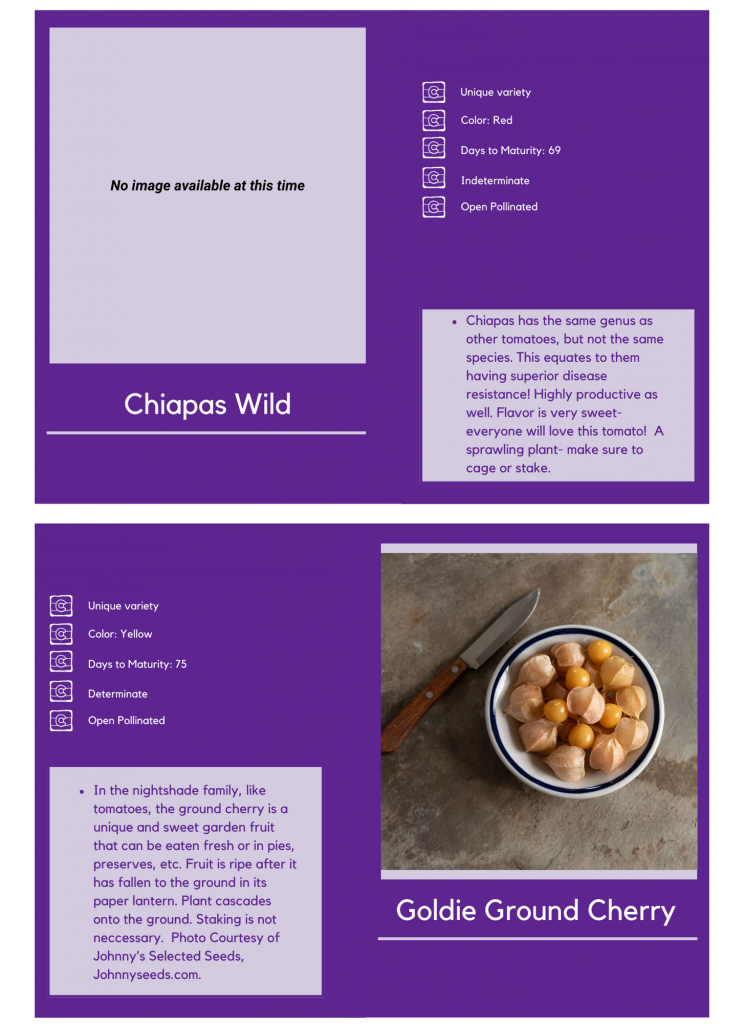


The Gothic Vegetable Garden
By Katherine Placzek
Black & purple vegetables are not only for someone who is looking for a fun or Gothic vibe in their garden. Purple-ish fruits and vegetables have higher antioxidants, which play an important role in protecting your cells against heart disease, cancer, and other diseases. So it is healthy for you to plant and eat these dark maroon beauties!
All of these vegetables are carried by us as seeds through the Botanical Interests or Lake Valley Seed brands (both CO businesses). There is a wide array of purple/ black vegetables so feel free to go down the rabbit hole and create the dark and mysterious garden of your dreams! Note that various seeds may be out of stock throughout the season.
Amaranth
Burgundy: These plants offer beauty and sustenance! The plants can get tall and have elegant and eye-catching burgundy plumes that can be used in flower arrangements. The seeds were a major crop of the Aztecs, and are very high in protein and other nutrients. Cook the beige seeds like rice. Young leaves are also edible- use them in salads or steamed. The birds will also enjoy the seeds!
Basil
Cardinal: Cardinal’s’ deep crimson blooms allow this basil variety to be utilized beyond its culinary qualities! Use it as a surprising accent in a mixed container, or use it as a cut flower! The fragrance is lovely. With its strong scent, a little goes a long way in the kitchen. A wonderful dual-purpose herb.
Purple Petra: A deep purple, this basil adds vibrant color to any dish! A more mild basil- great for those who just want the essence of basil in their cooking. ‘Purple Petra’ can be used to make an elegant pink-tinted vinegar also! Use it as a companion plant to your nightshade veggies or as a statement plant in an herbal ensemble or annual flower container.
Purple Opal: Opal Basil has eye-catching purple leaves, and will bloom during the summer with light pink flowers. Feel free to fall in love with this variety! Grow it just for its rich beauty or for its culinary uses. Highly flavorful, this basil variety has flavor notes of cinnamon, anise, mint, and clove!
Siam Queen Thai: This beautiful basil has a complex sweet and spicy flavor with a hint of anise. Broadly used in Thai and Vietnamese dishes- it is versatile! It is easy to grow and highly ornamental with its dark amethyst blooms. Flower farms also grow Thai basil, for cut bouquets. Include it in your garden flower bunch and enjoy the unique fragrance. Bees also love this stuff!
Sweet Thai: Thai basil is of course a popular herb in many Southeast Asian cuisines, and is most regularly highlighted in a warm bowl of Vietnamese pho. This variety holds its flavor and texture through cooking more than other basils. Lovely in salads or when eaten fresh. Sweet Thai’s dark purple flowers and intoxicating scent allow it to double as an excellent addition to the flower garden. Produces well in containers also.
Beans
Royal Burgundy (Bush): Royal Burgundy has yummy purple pods that are easy to spot among green leaves. A wonderful variety to grow in cool weather and is unlikely to be challenged by bean beetles. A good container variety, as well as disease-resistant.
Trionfo Violetto (Pole): Trionfo Violetto’ translates to “purple triumph.” This Italian heirloom will win your heart, with its crisp and flavorful purple pods. While highly ornamental the plants are also highly prolific! The plants climb 6’–8′, and have prolific light amethyst flowers that bloom against green leaves that sport purple veins and stems. Similar to other purple beans, the pods magically turn green when they are cooked!
Beets
Bulls Blood: Plant one row of this beet variety for the beautiful greens, and another for the flavorful roots! ‘Bull’s Blood’ is valued for its tender, sweet, and deep red– almost plum foliage. Originally selected from a French heirloom for the darkest colored leaves, the 16″ “greens” are rich in nutrients! The roots are delicious as well, especially so, when harvested small. Use in succession planting as multiple crops are possible throughout a season.
Broccoli
Burgundy: This variety of broccoli is considered a “sprouting broccoli” since it produces one small main head, but then produces generous side shoots. Purple broccolis tend to be tender, flavorful, and full of antioxidants! ‘Burgundy’; is tolerant of a wider range of temperatures, which allows a longer harvest period. Some gardeners prefer to pinch the main floret off early on, to encourage more abundant side shoots. Also resistant to the disease, Fusarium yellows.
Cabbage
Red Acre: Jazz up cole slaw or any stir-fry with this gorgeous, deep-fuchsia cabbage! This variety has a very fresh and sweet flavor. Solid heads form early and grow on compact plants making ‘Red Acre’ an ideal choice for urban gardeners who may have limited space. Resistant to splitting as well as cabbage yellows disease. The heads store very well, in the refrigerator or a root cellar. A variety you must try!
Carrots
Cosmic Purple Carrots: While various colored carrots seem to be the new fad, they have been around for centuries. In fact, the purple carrot has been around for at least 1,000 years! While previously unpopular compared to orange carrots, purple carrots have been rediscovered, and rightfully so! Besides being high in vitamin A, purple carrots contain anthocyanins (an antioxidant) that are common in blueberries. Kids will love them!
Eggplants
Black Beauty: A beautiful nearly black vegetable with lovely, lavender blossoms pretty enough to grow in the flower garden! ‘Black Beauty’ has set the standard since 1902 for large and high-quality fruit. When harvested at its peak, the skin is tender, so no need to peel it; making it perfect for eggplant parmesan, ratatouille, and grilling!
Finger Fruit Purple: Grow fast-producing clusters of beautiful eggplants on your patio or a sunny corner of your vegetable plot! These 4-6″ fruits contain few seeds and have thin, tender skin—perfect for stir-fries and roasting. A plethora of royal purple fruits on just 22-38″ tall plants make this variety a perfect fit for containers and small gardens.
Jewel Amethyst: ‘Jewel Amethyst’ is perfect for containers, since it has a tidy habit. You will also notice its growing pattern makes harvesting a joy! The oval, purple fruits are best harvested when about 3”–4 ½” long, to stay tender. Harvest regularly from this variety to keep eggplant producing throughout the season.
Long Purple: This long, slender variety, is not usually found in grocery stores, and is a treat! Sometimes called ‘Italian Long Purple’, this prolific heirloom will bring beautiful ruby-purple color to the garden and savory goodness to the table. Enjoy in a wide variety of dishes!
Kohlrabi
Early Purple Vienna: Early Purple Vienna kohlrabi is an easy-to-grow cool weather crop that forms a distinctive dusty lilac bulb with pale flesh above ground. A beautiful plant! Peel its crunchy bulb and enjoy it raw or cooked. Leaves are also edible- eat similarly to collards, or other steamed greens. Kohlrabi is high in fiber, making it an excellent veggie for overall gut health. Kohlrabi is also high in isothiocyanates and glucosinolates, which are powerful antioxidants, thought to lower the risk of certain cancers, heart disease, and inflammation. Keeps well in the fridge.
Lettuces/ Greens
Brentwood Lettuce: This variety produces pretty burgundy lettuce leaves making for some beautiful salads! The heads produce high yields in compact spaces, and their bolt resistance allows for a long harvest. Also resistant to downy mildew, lettuce leaf aphid, and Fusarium wilt.
Dazzling Blue Kale: You will be mesmerized by the beautiful colors of this extra-cold-hardy kale. It is even more cold-tolerant than other lacinato types. The purple midrib pops against the blue-green leaves, some of which may take on more purple hues in the cool temperatures of fall. Lacinato kale is ideal for kale salads. Pick tender, baby greens for fresh salads, chips, or sauteing, in just 30 days!
Marvel of Four Seasons: Tasty and attractive, this 1800s French heirloom is also known as Merveille de Quatre Saisons. The variety has sweet and tender leaves that are chartreuse green at the base, turning to a beautiful cranberry-red, and forming a crinkly rosette! Gorgeous! Rosettes are 8″–12″ in diameter and good for large containers.
Red Russian Kale: Typically, kale gets sweeter after the first fall frost. ‘Red Russian’, on the other hand, is sweet and tender all the time. The lavender veins are part of what makes ‘Red Russian’ as attractive as it is delicious. Harvest baby greens in just 21 days!
Truchas Mini Romaine: This deep-merlot, mini-romaine is a game-changer for salads! ‘Truchas’ is compact and easy to grow in small spaces. It also creates gorgeous contrasts with green lettuce. Uniform leaves stay upright in the garden and make for easy plant cleanup. Has disease resistance to downy mildew, lettuce die-back, and lettuce mosaic virus.
Nasturtium
Black Velvet: These edible beauties add glamorous, ruby-black color to your salads and cheese plates! All parts of the flower (leaves, seeds, stems and flowers) are edible! Garnish tacos, avocado toasts, and pasta dishes with these beauties! Excellent as a companion plant to your tomatoes, and they repel several pests. Gorgeous in containers as well.
Tom Thumb Black Velvet: Tom Thumb features velvety, nearly black flowers with contrasting bright green foliage! Compact plants make this an outstanding choice for the border and containers. All parts of the flower (Leaves, seeds, stems and flowers) are edible! Add flowers to charcuterie boards, gazpachos, strewn on roasted root veggies, or create vinegar from them, for various culinary experiences!
Okra
Red Burgundy: Whether you eat okra or not, this plant is worth growing, just for the beauty of it! The pods are deep crimson edging toward maroon and are preceded by gorgeous yellow flowers that the bees love. This is the most productive red variety and will produce tender, 6″-long pods that are delicious in soup, gumbo, and stew, or deep-fried.
Shiso
Green and Red Shiso Perilla: An absolute must for herb gardens! Also called Japanese basil or the beefsteak plant, shiso’s incredible flavor can be described as a combination of cinnamon, mint, and clove with notes of cumin. A beautiful, heat- and drought-tolerant bedding plant that attracts pollinators, and is excellent for containers. This packet provides 75% green shiso and 25% red (shows up as a deep mulberry color).
Snap Pea
Sugar Magnolia: Wow, a purple snap pea that is tender and delicious! Enjoy the pretty purple blooms first, then the purple pea pods. Eat them without shelling, dipped in hummus, in a salad, or in stir-fries! Long hypertendrils (vigorous, multi-branching tendrils) support the 6′-7′ vining plants. This growing pattern creates an airy structure that helps prevent mildew. Some of these open-pollinated peas may be flecked with green, or be fully green.
Tomatillo
Purple: A purple tomatillo! Not only delicious but alluring also. The purple fruits are much sweeter than the green types and rich in antioxidants. Let the fruit remain on the plant as long as possible until the papery husks split for the best flavor and color. Tomatillos grow best in conditions similar to tomatoes (because they are related) but will handle a lot more heat. Tomatillos require cross-pollination so plant at least two plants in your garden to ensure good fruit production
Tomatoes
Black Krim: This Russian pole heirloom originated in Krymsk on the Black Sea in Russia. Baseball-sized fruits weigh 10–12 ounces and have dark reddish-brown flesh filled with a rich, slightly savory flavor. Fruit sets well in heat and is a reliable “black” tomato, producing even under adverse conditions from summer to fall. Make sure to stake or cage, as the plants can reach 6′ or more!
Cherokee Purple: Cherokee Purple’ is said to have been given to a Tennessee family by the Cherokees over 100 years ago. This dark maroon tomato has just the right balance of sweetness and even a hint of smoke, making it a winner in taste competitions. From summer into fall, you will harvest lots of 10–12 oz. tomatoes from this well-regarded heirloom variety. Make sure to stake or cage, as the plants can reach 6′ or more!
Chocolate Cherry: Chocolate Cherry tomatoes—Yum! These 1″ purplish-red, delicious tomatoes are great for snacking on and add a bit of sweetness to salads and pasta. The prolific vines bear seemingly endless trusses with 6–8 ounce fruits that will bring you back for harvest after harvest. Fruit is crack-resistant! Make sure to stake or cage.
Watermelon
Sugar Baby: The taste of summer? Watermelon! As the name suggests, ‘Sugar Baby’ is sweet, sweet, sweet! It is also small enough to easily fit in the refrigerator. This plant produces a bountiful crop of 8–10 pound deep dark emerald green orbs that have juicy red flesh.
Zucchini
Black Beauty: Black Beauty is an early maturing zucchini-type squash that features delicious deep black to green fruits with pale flesh. A very easy-to-grow bush variety that is highly productive all summer long. Enjoy grilled, sauteed, fresh, in soups, or zucchini bread!
